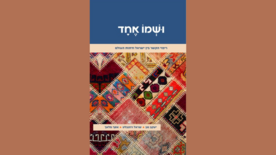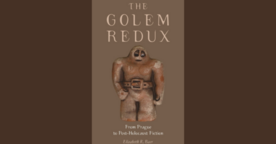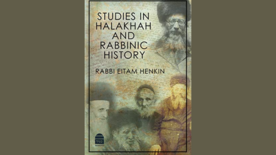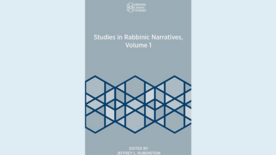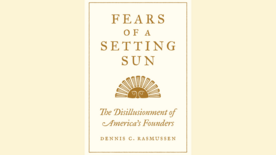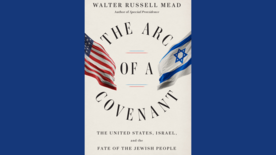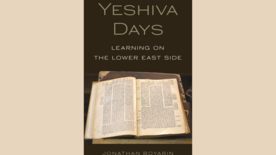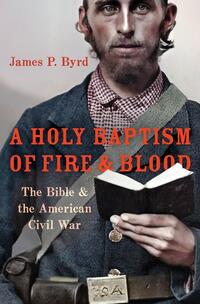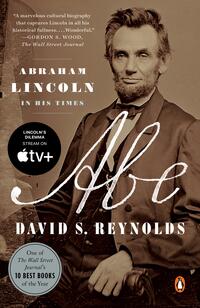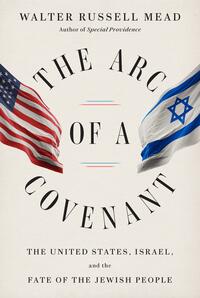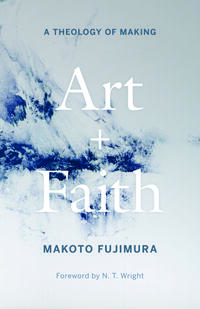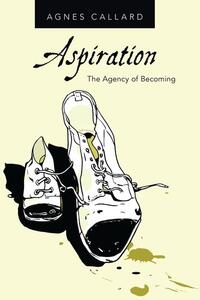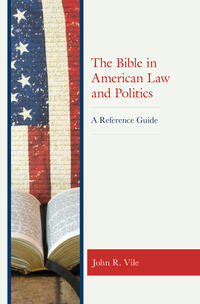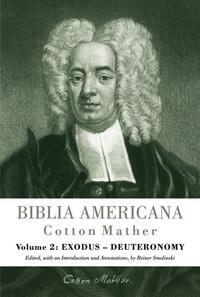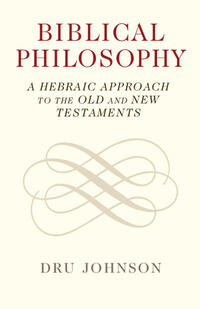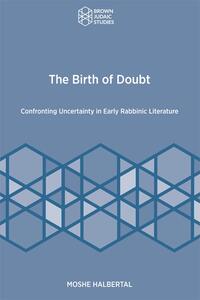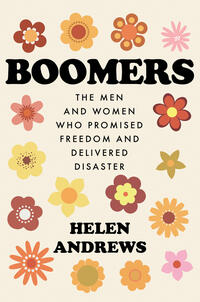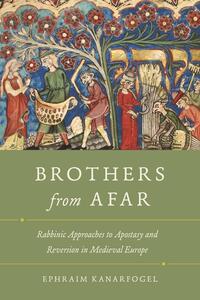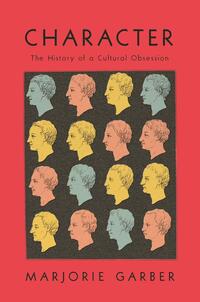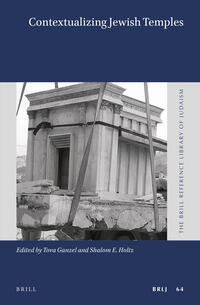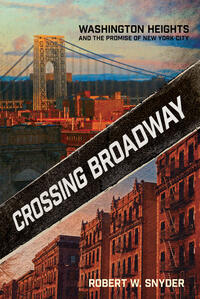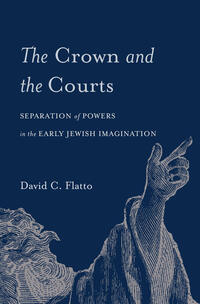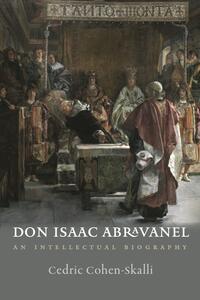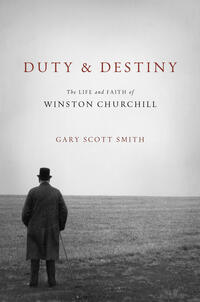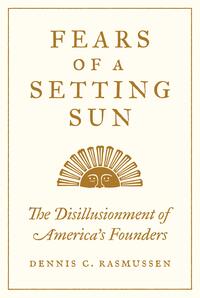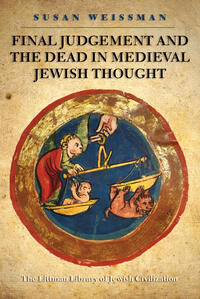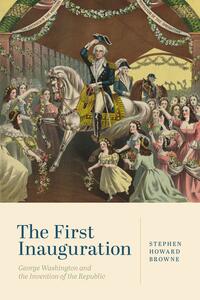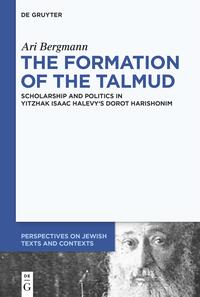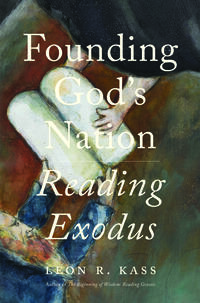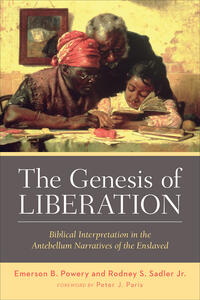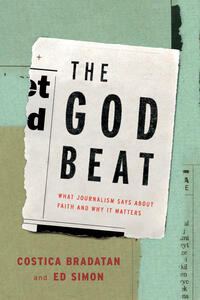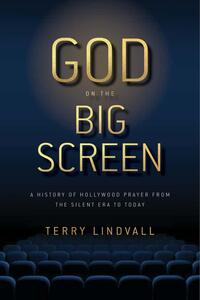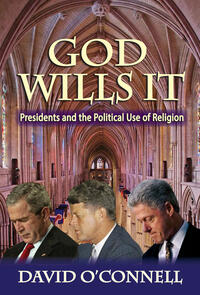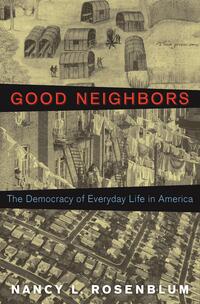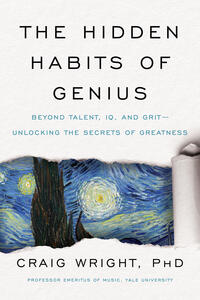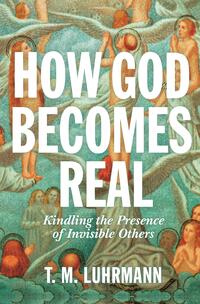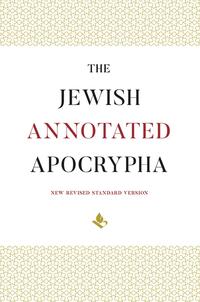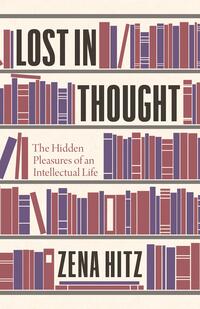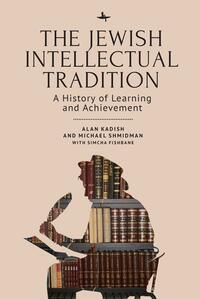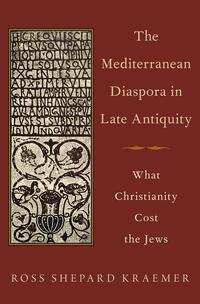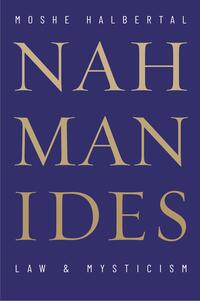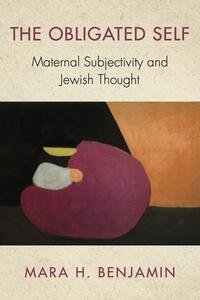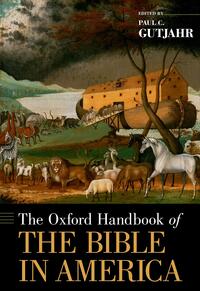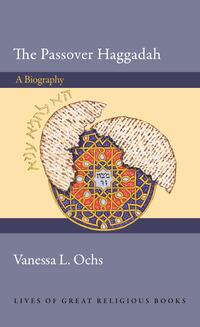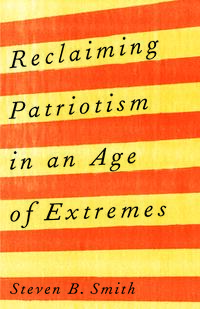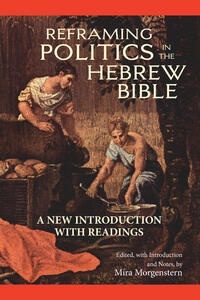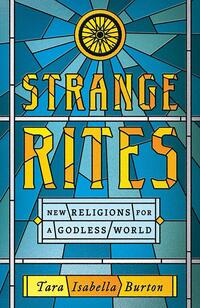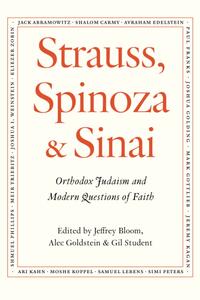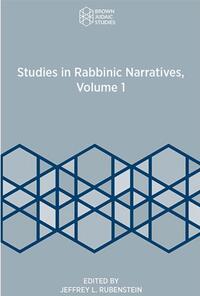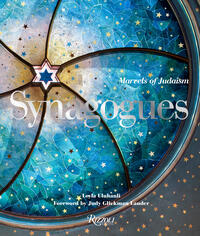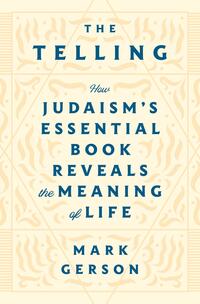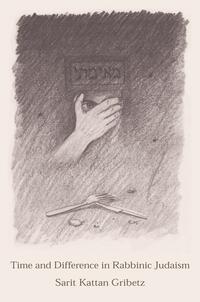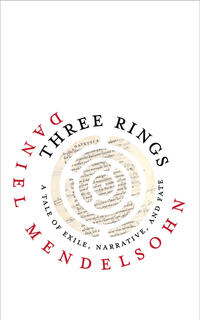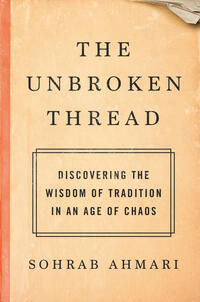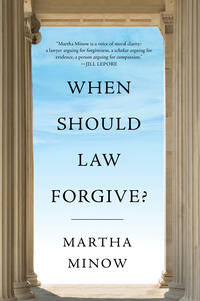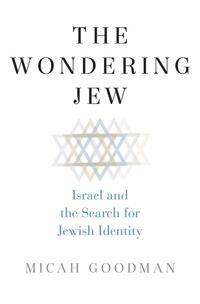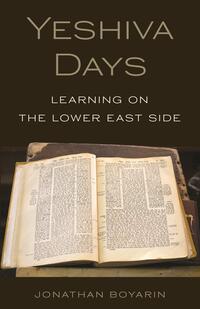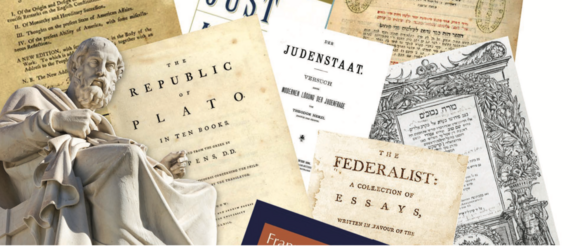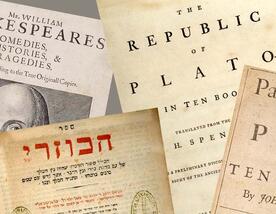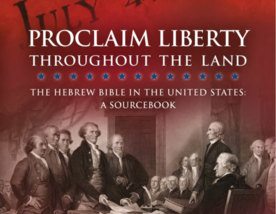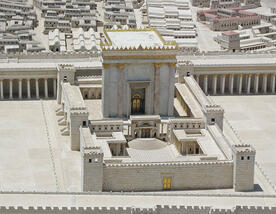
What the Straus Center Is Reading
Reviews of the latest works in history, philosophy, culture, politics, and Jewish thought by Straus Center faculty and staff
Recent Reviews
A Holy Baptism of Fire and Blood: The Bible and the American Civil War
James P. Byrd | Oxford University Press | 2021
Reviewed by Rabbi Dr. Stu Halpern
In his A Holy Baptism of Fire and Blood: The Bible and the American Civil War, James P. Byrd gifts readers with another comprehensively chronicled and extensively analyzed survey of how Americans, in the country's earliest decades, were politically inspired by the Bible. Byrd, a professor of American religious history at Vanderbilt University Divinity School, previously authored Sacred Scripture, Sacred War: The Bible and the American Revolution. In his latest, he offers the first full-length treatment of what Abraham Lincoln meant when, in his Second Inaugural Address, he remarked that both sides of the Civil War "read the same Bible and pray to the same God, and each invokes His aid against the other."
As Byrd deftly demonstrates, biblical figures, verses, themes, and scenes were both the theological and political backbone to both North and South. Take, for example, the story of Achan in the book of Joshua. In that tale, Achan is an Israelite who steals property, leading to the collective punishment of his kinsmen by the hands of God in the form of a lost battle. Northern preachers argued that the story demonstrated that the Southern slave owners, like the wicked Achan, claimed possessions that they had no right to and deserved the wrath of God. The Southerners, on the other hand, argued that slave ownership goes unmentioned in the biblical tale, and it was the abolitionists, who were attempting to relieve Southerners of their property, who were being Achan-like, meddling in what did not belong to them.
As Byrd notes, citing historian Jill Lepore, wars have "wounds and words," with the latter meant to contextualize and provide meaning behind the former. Put simply, preachers and pundits turned to the Bible to reassure themselves they were right and that God was on their side. Even non-believers turned to the Bible for protection, pocketing miniature versions in their uniforms.
This manifold seeking of God's word to enlighten the conflict manifested itself in a startlingly wide range of biblical allusions (quantified using data analysis in the appendix to the book). Frederick Douglass cloaked himself in the words of the ancient biblical prophets, as his biographer David Blight, who Byrd cites, has noted. The influential novel Uncle Tom's Cabin contains over 100 allusions to the Bible. From Samson to Jezebel, Esther to Isaiah, both sides saw themselves as ancient Israel redux. The South saw the North as an oppressive Pharaoh, while the North couldn't stand the South's reliance on slavery, the very thing which God had freed the Israelites from in Egypt.
Even the most violent extremists were justifying their actions through a biblical lens. John Brown saw his ill-fated raid on Harper's Ferry as a Samson-like suicide mission, and John Wilkes Booth, Lincoln's assassin, lamented as he fled the authorities that he would be marked with the "curse of Cain." (Sure enough, a Presbyterian minister from Des Moines, Iowa, told his flock that "if Cain deserved to be punished sevenfold, surely [Booth] deserves to be punished seventy and seven fold.")
Surprisingly, as Byrd stresses, Lincoln himself possessed no such surety of the righteousness of his cause in the mind of God, and his Second Inaugural is a lesson in political humility and magnanimity.
Byrd concludes, "The Bible was a constant in the Civil War, but it was also constantly debated, its meaning shifting with each interpreter to every crisis. Americans were never in more disagreement over the Bible, and yet never more in agreement that the Bible proved the sacredness of war." As his second invaluable contribution to the interpretive history of the Bible in America makes clear, it is Byrd's historically and spiritually attuned gifts that are beyond debate.
Abe: Abraham Lincoln in His Times
David S. Reynolds | Penguin Books | 2021
Reviewed by Rabbi Dr. Stu Halpern
David S. Reynolds' Abe: Abraham Lincoln in His Times is a brilliant analysis of Lincoln's family, personality, and political positions within the context of his era.
Reynolds, a professor in CUNY's Graduate Center, notes that while there are already 16,000 books about Lincoln, none attempt to demonstrate how he fit in, responded to, and contrasted with the cultural winds of his time.
Readers learn that despite the hardships Lincoln's family faced—his mother was born out of wedlock, his father was barely literate, and Native Americans murdered his paternal grandfather—young Abraham did not grow up as poor as is usually believed. His father was a well-respected carpenter, and the family's landholdings were listed in their county's tax rolls as being in the top 20. Though he had a strained relationship with his father in later years, Lincoln inherited his physical strength and temperate nature from him, largely avoiding alcohol consumption.
Lincoln, whose later political rhetoric often rang in a biblical key, composed, as a young man in the 1820s, a faux-biblical poem called the "Chronicles of Reuben." In it, Lincoln mocks a man of the same name after the latter refuses to invite Lincoln to his wedding. (Lincoln's humor, a life-long trait, matched the scatological and bawdy style of his time.) Lincoln's own romantic pursuits are extensively documented, including his loves before his eventual wife, Mary Todd, whose notoriously difficult personality receives an extensive and sympathetic analysis.
Lincoln's gangly and awkward appearance is fascinatingly contextualized within the context of the rise of P. T. Barnum and his human curiosities. "Just as Benjamin Franklin had won great popularity by posing publicly as the bumpkin Poor Richard," Reynolds writes, "so Lincoln performed as the lowly Uncle Abe. He was the humble American as political spectacle. His homely averageness was, in Hawthorne's words, 'exaggerated' and 'extravagant.'"
Lincoln's progressive views on black liberation (contextualized within the racial theories of his time) are appreciated for their innovative nature, as is his support of women's suffrage over a decade before the famous Seneca Falls women's rights convention. Lincoln's kindness towards the American Jewish community is also noted, with one rabbi referring to the president as "rabbi Abraham" and crediting him with a Judaic spirit.
Mary Todd's Spiritualism, Lincoln's suspension of habeas corpus, his affinity for Shakespeare, and his frequency at the theater (including his invitation to an actor he was fond of, John Wilkes Booth, which went unanswered) are just a few aspects historically contextualized in the wondrous portrait that is Abe. Readers interested in leadership, the history of American culture, and the life of America's greatest president will be richly rewarded by this luminous volume.
The Arc of a Covenant: The United States, Israel and the Fate of the Jewish People
Walter Russell Mead | Knopf | 2022
Reviewed by Rabbi Dr. Stu Halpern
In The Arc of a Covenant: The United States, Israel and the Fate of the Jewish People, The Wall Street Journal’s Walter Russell Mead offers a revisionist history of the relationship between America and the Jewish State. As Mead writes, “The conventional narratives about the relationship were often off base and sometimes flat wrong.” As he argues, long before modern Jewish political Zionism, non-Jewish Americans looked toward Jewish restoration in the Holy Land. In fact, how Americans feel about Israel has often been less about Jews and more about what they perceive America’s values to be, what role they think their country should play in the world and their own (usually Christian) religious faith. In one of the book’s main counterintuitive arguments that rings true, Mead notes that modern Israel has served as a religiously edifying testimony to the faith of millions of American Christians well versed in the Bible. In other words, while Christians helped and continue to help Israel’s modern revitalization, Israel, in turn, has actually helped strengthen Christians’ religious commitment. Of course, as the Straus Center has argued in its books Proclaim Liberty Throughout the Land: The Hebrew Bible in the United States and Esther in America, and as Mead recounts, America since the Pilgrims and the Puritans turned to the model of ancient Israel to shape their own communities and political ideology (there were only around 1,000 actual Jews in America during the Revolutionary period).
Countering the commonly heard arguments that much of American foreign policy is influenced by Israel, Mead argues that the U.S.-Israel relationship isn’t and never has been the most important relationship in America’s foreign policy and reminds his readers that Israel is far from America’s most valuable trading partner or important ally. He cautions against looking at the relationship between the two countries in a vacuum and not within its proper place—part of the endlessly complex web of geopolitics and strategic interests. He also slays some sacred cows, making the case that Joseph Stalin’s arms deliveries were more significant in Israel’s birth than Harry Truman seeing Israel as a means of keeping his Democratic Party united, and France as more crucial to Israel’s survival in its first 20 years than the U.S. He notes that it clearly wasn’t “Jewish pressure” that “engineered the vote” for Israel in the UN, since “one wonders how the world’s Jews, powerless a decade before to stop the rise of Hitler in Germany…powerless to force a war-weakened Great Britain to toe the Zionist line, had suddenly gained the awesome power to manipulate the United Nations behind the scenes.”
Mead, of course, spends ample time on “The Great MacGuffin and the Quest for the Holy Grail,” i.e., the Middle East peace process. As he notes, though not great headway was made in recent decades prior to the Abraham Accords, “Presidential trips to the Middle East always led to favorable press coverage, underlining the difference between a president and lesser mortals who competed against him politically.” He also adds that those pushing for progress view the end goal as the establishment of some sort of universal liberal order that would actually feel foreign to the region’s native inhabitants, and that on some level, “peace is already here” since “most of the time, Israelis and Palestinians are not actually shooting at one another.” Furthermore, Jews are understandably skeptical of others telling them how to live in security and dignity, noting that Herzl’s argument was that only the sovereign power of a Jewish homeland offers real hope for survival.
Readers interested in Middle East history, Zionist history and U.S. foreign policy will gain much from Mead’s learned and well-argued work. The book’s subtitle notwithstanding, the actual fate of the Jewish people, of course, remains ultimately in God’s hands.
Art and Faith: A Theology of Making
Makoto Fujimura | Yale University Press | 2021
Reviewed by Rabbi Dr. Stu Halpern
In Art and Faith: A Theology of Making, artist and theologian Makoto Fujimura offers a moving meditation on what it means to create.
Referring to God as the One True Artist, Fujimura often turns to the Bible in considering what it means to craft something. Alluding to the rivers that sprung from Eden, including the Phishon—where Genesis tells us "the gold could be found"—Fujimura notes that "Even in Eden the gold was hidden. We have work to do." Thus, art is nothing less than a sacred calling. "When we make," he writes, "we invite the abundance of God's world into the reality of scarcity all about us." Humanity is by nature a creative being, and "the Bible is full of Making activities." As Fujimura notes, Bezalel and Oholiab, the Bible tells us, were filled with the Spirit of God as they set out to craft the Tabernacle in the wilderness. There is something profoundly moving and empowering, he argues, in God inviting humans to be his co-creators.
One of the more fascinating parts of the slim volume is the author's discussion of kintsugi, the ancient Japanese art of taking broken pieces and, by piecing them together, making something more beautiful than before. The Japanese "kin" means "gold" and "tsugi" means "to reconnect." The latter also connotes "connecting to the next generation." Thus this artistic tradition offers room for reflection on how generations repair and build off of the work of their ancestors. The broken shapes become necessary in shaping what comes next. Thus, Fujimura writes, "we need to find our own mending to be a collage-like journey toward healing." Looking back on his own journey toward faith, the author notes that "A journey toward the New begins with such an experience of raw authenticity of brokenness, tears, and healing."
Fujimura argues that places of worship should seek to embrace creativity to engage worshipers. Writing as a religious Christian, he notes that "churches are not investing enough time and effort in thinking about the context of communication, and they are not empowering makers." Forging a space whereby creative imagination can flow is crucial to religion's success. After all, as he notes, invoking Martin Luther King Jr., "Our ability to dream, to envision the future in which justice reigns is one of the great gifts of God to us. And as we are made in the image of God, we are capable of this kind of dreaming."
Appropriately, Art and Faith closes with a prayer. "Let us reclaim creativity and imagination as essential, central, and necessary parts of our faith journey," Fujimura writes. "Imagination is a gift given to us by the Creator to steward, a gift that no other creature under heaven and earth (as far as I know) has been given."
Aspiration: The Agency of Becoming
Agnes Callard | Oxford University Press | 2019
Reviewed by Rabbi Dr. Stu Halpern
In Aspiration: The Agency of Becoming, University of Chicago philosopher Agnes Callard offers a learned investigation into the nature of value acquisition. Defining “aspiring” as the wish to acquire new value, Callard offers her own perspective on the scholarly theories relating to the moral psychology, decision-making and philosophical aspects of self-creation. As she writes, “Aspirants aim to direct their own ethical attention in such a way as to more fully appreciate one value or set of values and to become immune or insensitive” to those oppositional values. There is always, after all, something else we could decide to value.
Though not explicitly Jewish beyond mentioning the early Zionists as a group whose decision-making has been the subject of academic research, the volume offers an interesting parallel to rabbinic thought on self-improvement and obedience to the commandments. “Mitokh she-lo lishma bah lishma” (performance without the proper intention leads to performance with the proper intention) bears a striking resemblance to Callard’s noting of the phenomenon, building off of the research of J. David Velleman, that those seeking value-laden change perform “versions of the actions they will be in a position to perform once they have fully acquired the value.” On the road to full realization of the values one seeks, one, essentially, fakes it until one makes it. “We cannot hold off from making use of our values until such time as they are securely in our possession,” she writes. “For what happens in the meanwhile is also life.” When she writes that “Aspirants have a more ambitious goal than self-maintenance. They work to build themselves into something genuinely new,” one cannot help but think of a ba’al teshuva. Her discussion of the Greek concept of akrasia, exhibiting weak will or acting against one’s better judgment, would be well-served compared to the concept of the yetzer hara (evil inclination).
Aspiration, the author argues, is cultivated in community. Teachers, parents, mentors, therapists, coaches, friends, and fellow aspirants all help the agent develop the value she or he seeks. The road is hardly smooth or easy and often involves navigating between competing value perceptions. “Aspirants step forward—little by little—into a state of lessened conflict.” They struggle through vagueness and grasp what they hope to achieve. Callard acknowledges that other factors beyond her study play a role in decision-making. Financial, emotional, and temporal resources also contribute. But undoubtedly, further research will build off of Callard’s valuable contribution to understanding how and why people aspire.
The Bible in American Law and Politics
John R. Vile | Rowman & Littlefield | 2020
Reviewed by Rabbi Dr. Stu Halpern
“...for pathos of narrative; for the selections of incidents that go directly to the heart; for the picturesque of character and manner; the selection of circumstances that mark the individuality of persons; for copiousness, grandeur, and sublimity of imagery; for unanswerable cogency and closeness of reasoning; and for irresistible force of persuasion; no book in the world deserves to be so unceasingly studied, and so profoundly meditated upon as the Bible,” wrote John Quincy Adams in a letter to his son, George Washington Adams, in 1813.
As John R. Vile demonstrates in his encyclopedia, The Bible in American Law and Politics, Adams, and his son’s namesake, were among the countless American leaders who turned to the Bible to speak to, and about, the American project. An invaluable tool for all those interested in the role the Bible has played in American public life, Vile’s work provides relatively short and immensely useful entries surveying and distilling scholarship on a tremendous array of subjects.
The author, professor of political science and dean of the University Honors College at Middle Tennessee State University, leans heavily on recent seminal works on the role the Bible has played in American political and legal thought, including by Harvard University’s Eric Nelson, American University’s Daniel Dreisbach and the University of Haifa’s Eran Shalev, to provide the most up-to-date research on the topics covered. Dreisbach, as Vile notes, has documented at length how rhetorical uses of the Bible by American politicians enrich a common language and cultural vocabulary, enhance the power of their speech, evoke ancient and transcendent rules, and illuminate the role of Providence in American history in numerous articles and Reading the Bible with the Founding Fathers.
Many of The Bible in American Law and Politics’ entries center on the concept of America as a new Israel, including Puritans comparing their arduous sea journey to the ancient Jews crossing the Red Sea, Benjamin Franklin and Thomas Jefferson contemplating depicting the Exodus from Egypt as part of the American Seal, and jeremiads in which American leaders would thunder rebuke to their constituents as the prophets of old.
Plenty of quirky and lesser-known topics sit alongside expected subjects like the Scopes Trial, the Liberty Bell (on which Vile authored an entirely separate encyclopedia), George Washington’s comparison to figures such as Moses and Gideon, and verses cited in presidential inaugural addresses. We learn that biblically inspired “days of humiliation, fasting and thanksgiving” were undertaken both in early America and George III-led Great Britain. During the “Bible Balloon Project” between 1953 and 1957, helium balloons from West Germany dropped bibles into Eastern European nations controlled by the Soviet Union. The Bible has been used to defend environmental efforts and argue for and against capital punishment. Noah Webster, of dictionary fame, wrote multiple books on the Bible, including 1834’s Value of the Bible and Excellence of the Christian Religion: For the Use of Families and Schools. And multiple American figures have been compared to the evil queen Jezebel depicted in the biblical book of Kings.
Students of American history, biblical interpretation, and political rhetoric, as well as all those seeking a fuller appreciation of the immeasurable impact the Bible has had, and continues to have, on the American story, stand to gain much from Vile’s exhaustive and engaging work.
Biblia Americana: America's First Bible Commentary: A Synoptic Commentary on the Old and New Testaments: Exodus-Deuteronomy
Cotton Mather | Mohr Siebeck | 2019
Reviewed by Rabbi Dr. Stu Halpern
Cotton Mather (1693-1728), the popular Puritan minister, accomplished scientist, prolific author, grandson of Massachusetts Bay Colony spiritual leaders Richard Mather and John Cotton, and son of Harvard President Increase Mather, had much to say on many topics, writing over 460 books over his 65 years. Yet his magnum opus, Biblia Americana, has only recently been published by a team of scholars led by Georgia State University’s Reiner Smolinski.
The first American commentary on the whole of the Hebrew Bible and New Testament, the work was too lengthy and unwieldy to be published during the author’s lifetime. Its appearance in recent years now offers a treasure of insights into a variety of disciplines, not limited to American history and biblical interpretation, as can be seen by a look inside the 1461 page Volume 2: Exodus - Deuteronomy. For someone with a background in Jewish biblical interpretation, the work is particularly fascinating.
Mather is as comfortable crediting the Bible for influencing Greek thought (“Plato would have his well governed City, divided into Twelve Tribes. Behold, an Imitation of the Division of the Israelitish Nation!”) as he is demonstrating how kohanim differed from pagan priests (“The Heathen Priests, did not seldom with Castration preserve Chastity, or, by Juice of Hemlock, not so much Flie from Lust, as Putt it unto Flight. The Jewish Priests knew none of these Hardships.”)
His descriptions of Jewish practice are often both detailed (eg. “For which Cause, the Jewes to this Day, do with so much Exactness avoid, all Communion with this Rite, that at their Tables, Flesh and Milk, must not be seasoned with the same Salt, not Flesh and Cheese cutt with the same Knife”) and admiring (he describes Shemini Atzeret and Simchat Torah thus: “On this Day, they sojourned not in Tabernacles; as they did on the Seven praeceding… they returned unto their Houses, & they kept a very great Solemnity there, unto another Purpose, than that for which those Dayes had been appointed. Then they not only made great Feasts in their Houses, but they also sang the Praises of God at the Temple, with Trumpets & Instruments of Musick.”).
His interpretive explanations are often strikingly creative even when lacking textual basis, such as when he connects the horns of the Golden Calf to the radiance of Moses’ face (“I will add, methinks, the Holy & Faithful Zeal of Moses against the Golden Calf, may have a Sensible Reward in the Glory thus vouchsafed him. Hee destroy’d an Idol that had Brutal Horns; God Rewards him with Divine ones.”) He also suggests that the utensils in the Tabernacle mirror the human body (“The Throne, the Incense-Altar, the Table, and, the Candlestick; not unaptly answering, in their Number, and Scituation, to the Brain, the Heart, the Stomach, and the Liver.”).
Structurally, the commentary is offered in question and answer form, such as this charmingly conceived explanation for how retired Levites spent their time:
The Levites how might they spend their Time, after they were by Age discharged from the laborious Part of their Service?
They had then Time to apply themselves unto Learning & Study; by which Means, they became Expert… in Medicine and Policy and other Liberal Arts. Thus they became able to do Good among their Neighbours & govern Schools for the Education of Youth, & qualified for high Posts in Governments; and many of them were advanced unto the principal Offices in the Commonwealth.
Another fascinatingly offered suggestion is his attempt to explain why Aaron and Miriam spoke ill of Moses, and how that related to his wife:
Probably, they were Jealous of Moses’s being too much ruled by his Wife & by her Relations; For it was by her Fathers Advice, that he made the Judges, mention’d in the Eighteenth of Exodus. And perhaps they imagined, that she and Hobab, had a hand in choosing the Elders lately made… It is evident, those Elders were nominated, without consulting either Aaron, or Miriaim, about it. These taking themselves to be neglected, in so great an Alteration made of the Government, without their Advice, were very Angry. But because they durst not charge Moses directly, with this Neglect of them, they fell upon his WIfe; whom in Scorn they call, A Cushite, or Arabian Woman.
Alongside his comfort quoting traditional Jewish sources and beautiful descriptions of abidance of halakha (such as this description of Sefirat Ha-Omer: “Maimonides thinks, it was for the Honour of this Great Day of Pentecost, that they were to count the Dayes till it came; just like a Man; saith he, who expects his best Friend; he is wont to tell the Dayes and Hours till he arrive…. And this Counting sometimes is performed publicly in their Synagogues; yett so that every Master of a Family is bound every night for to do it at home.”), Mather is often disdainful of both Jews and their beliefs. He blames the death of Nadav and Avihu, Aaron’s sons, on their not knowing Jesus (“The Service of the Sanctuary, began with a Terrible Death; a Sad Intimation, that Life was not to bee obtained or expected from that Service; no, tis our Lord Jesus Christ alone, who is the Truth & the Life.”) and dismisses the Tabernacle in its entirety for similar reasons. (“While they see nothing of the Messiah in the Tabernacle, they make it a little better than a Tabernacle of Moloch.”)
Professor Smolinski and his colleagues have performed historic work in sharing with Americans, and all readers of the Bible, this previously unseen work of one of America’s earliest intellectual polymaths. Their decades-long project has been well worth the three-century wait.
Biblical Philosophy: A Hebraic Approach to the Old and New Testaments
Dru Johnson | Cambridge University Press | 2021
Reviewed by Rabbi Dr. Stu Halpern
In his Biblical Philosophy: A Hebraic Approach to the Old and New Testaments, Dr. Dru Johnson argues for the philosophical importance of the Bible. Johnson, an associate professor of biblical and theological studies at The King's College in New York City and director of the Center for Hebraic Thought, recounts once being asked at a conference, "Why are you at a philosophy conference making arguments from the Bible?" This volume serves as his response.
Johnson frames his book as a sequel of sorts to Yoram Hazony's The Philosophy of Hebrew Scripture (Biblical Philosophy is dedicated to Hazony). Agreeing with Hazony's general case, Johnson argues that "the idea of a Hebraic philosophical style" breaks many widely held notions about what counts as philosophy, the nature and purpose of biblical literature, and how societies have articulated notions of reality.
Johnson explains how, while some sectarian Jewish Second Temple texts "bent this Hebraic philosophical style to the point of breaking" due to Hellenistic influences, the New Testament modeled itself in line with the Hebrew Bible philosophically. Avoiding supersessionism, Johnson claims that "the Hebrew Bible's language and constructs seem to penetrate the thought world" of the Jewish New Testament authors.
The Hebraic constructs include a creation account that emphasizes God's relationship with the universe and its creatures, personal agency, rituals as means towards knowledge of God, and a community called upon to reflect on God's role in history. These themes are conveyed in biblical stories, stylized speeches, poetry, and law, many with "a rhetorical and persuasive force that makes them apt for philosophical engagement."
Egypt, contra the Hebraic model, held that the gods were assigned to and animated the natural world, saw only its citizens as fully human, maintained a formal distinction between justice and formal religion, and did not advocate a particular view of knowledge. Hellenistic modes of thinking contrasted with the Hebraic model in its lack of a defined canon and its linear arguments, autonomist ethos, and abstract convictions.
Some Jewish thinkers, like Philo, were deeply influenced by the Hellenistic framework, and the New Testament authors who followed in their wake were "surrounded by Hellenistic Judaism and the literary creations of that period" and "eschewed those works in favor of what they called 'the Scriptures.'"
Johnson's work is a learned study of the philosophical nuances of both the Hebrew Bible and the New Testament, and will appeal to both students of the Bible and those dedicated to philosophy generally. As he concludes, "For the sake of both biblical studies and philosophy/theology, more interdisciplinary work needs to include apprenticing with each other, collegial skybridges between the silos, and broader explorations into the material worlds of Scripture."
The Birth of Doubt: Confronting Uncertainty in Early Rabbinic Literature
Moshe Halbertal | Brown Judaic Studies | 2020
Reviewed by Rabbi Dr. Stu Halpern
In The Birth of Doubt: Confronting Uncertainty in Early Rabbinic Literature, Moshe Halbertal uncovers and unpacks the innovative nature of the rabbinic focus on legal doubt, or safek. As Halbertal, a professor at both NYU's law school and Hebrew University's philosophy department, documents, the Bible only dabbles in the concept of doubt with what he calls "ad hoc" examples, including the rituals related to sotah (a woman suspected of adultery) and eglah arufah (an unsolved murder case). Yet in the Mishnah, Tosefta and Talmud, the degrees of doubt are substantively articulated and analyzed.
Surveying concepts such as the kosher status of food found in a public place, purity, possession of property, Shabbat start times, lineage of a mamzer (bastard), and gender identity, Halbertal shows how the rabbis were quite comfortable wrestling with doubt's very nature. Noting numerous times throughout his study that the Apocrypha, Dead Sea Scrolls, Philo, and Josephus did not delve deeply into uncertain legal states, Halbertal presents the innovative nature of the rabbi's thinking. Instead of simply deciding that, say, food found in a public square was not kosher, they codified that if the majority of citizens were Jewish, the food could be presumed kosher, a decision that Halbertal calls both "astonishing" and "far-reaching" in light of its cultural and literary milieu. They created the legal concept of "bein ha-shemashot" (twilight), which impacts when Shabbat starts, despite there being no pre-rabbinic precedent for the concept, an interpretive move that Halbertal deems "truly a halakhic scandal."
As Halbertal details, much discussion of doubt reflects the rabbinic legal system's perceptions of values and the weight ascribed to them. The concern for saving even one life allows for the violation of Shabbat if there is even a chance that someone's death could be prevented. (As the author helpfully notes, there is no view in all of tannaitic literature that challenges this ruling.) Avoiding social exclusion of potentially impure individuals while not being paralyzed by concerns over uncertainty, the rabbis strike a healthy balance that "allow[s] a certain degree of contact with a complex reality that generates doubt and misgivings." Concepts like chazakah (presumption), for example, establish "halakhic anchors," limiting doubt from becoming an ever-creeping obsessive concern. Even when faced with differing perspectives on issues pertaining to marriage, as the houses of Hillel and Shammai were, the rabbis found ways to share both the beit midrash and the canopy, as the Talmud details.
The initial development of the legal nuances and degrees of doubt has, of course, flourished in subsequent Jewish tradition, including in later works Takfo Kohen by Rabbi Shabbetai Kohen and the Shev Shemateta by Rabbi Aryeh Leib Heller-Kahane. As Halbertal concludes, "the twilight zone of doubt and uncertainty proved to be fertile soil for the construction of a world alongside the real world."
Boomers: The Men and Women Who Promised Freedom and Delivered Disaster
Helen Andrews | Sentinel | 2021
Reviewed by Rabbi Dr. Stu Halpern
In her Boomers: The Men and Women Who Promised Freedom and Delivered Disaster, Helen Andrews takes on an entire generation. Andrews, a senior editor at The American Conservative, frames her work as following in the footsteps of Lytton Strachey’s Eminent Victorians, a 1918 work of short biographical portraits that argued against the purported heroism of British national icons of the time. Andrews, in turn, takes on the boomer generation’s sacred cows, including Steve Jobs, Aaron Sorkin, Al Sharpton, and Sonia Sotomayor. Idealized — but, in Andrews’ view, misguidedly so — the throughline of her critique of these icons represents how unsuccessfully boomers have navigated wanting to be both rebels and the establishment. As she writes:
Every generation is dealt its own challenges and handles them as well as it can. The boomers were dealt an uncommonly good hand, which makes it truly incredible that they should have screwed up so badly. They inherited prosperity, social cohesion, and functioning institutions. They passed on debt, inequality, moribund churches, and a broken democracy.
Jobs, for example, in encouraging people to “Think Different” and dedicating his life to changing the world through technology, thought that giving away charity was “a waste of time,” and Apple never had corporate matching for charitable donations when he was in charge. His anti-establishment streak left American culture saturated in perpetually adolescent Silicon Valley types who insist, as Andrews documents, “that everyone be super psyched about their jobs all the time.” The iPhone and video games have led to “the redirection of America’s productive energies into inducing and servicing addictions.” And the tech-focused children of boomers have subsumed their predecessors’ predilections. As Andrews notes, “The cool hippie liberalism that built Google doesn’t convince the millennials who work there that their elders are well-intentioned and deserve the benefit of the doubt. It tells them they’re easy marks.”
Sorkin’s sepia-toned portrayal of the White House in the West Wing is credited with changing how aspiring politicians view their jobs. As she puts it:
Sorkin encouraged DC staffers to think of themselves as a caste apart. Well-intentioned, hypercompetent, with the relevant facts at their fingertips at all times, these were just the sorts of people anyone would want to see running their country...one could easily come to the conclusion that such people ought to have as much power as they can get their hands on.
The chapter on Al Sharpton is offered through the prism of transformational vs. transactional leadership. As the author notes, the former can let their “rhetoric run away with them” in a way that the latter, more tied to reality, cannot. Transformational leaders often display an ability to actually see the bigger picture they are trying to transform.
When it comes to Justice Sotomayor, Andrews argues that her constant references to feeling out of place due to her disadvantaged upbringing are reflective of “boomers’ preoccupation with oppression, identity, and grievance... [which] create[d] many bullies, because it turns out that thinking of yourself as a victim can make you heedless of the ways your actions victimize others.”
Despite their self-congratulatory nature, boomers, Andrews concludes, have left their successors disdainful of institutions, devaluing loyalty to anything beyond themselves, and subject to ever-rapidly-changing value systems. Agree or disagree with Andrews’ politics, her sharply written and revisionist take on millennials’ parents offers both generations an intellectually stimulating read.
Brothers from Afar: Rabbinic Approaches to Apostasy and Reversion in Medieval Europe
Ephraim Kanarfogel | Wayne State University Press | 2020
Reviewed by Rabbi Dr. Stu Halpern
During the Middle Ages, how warmly would a Jew who converted to Christianity be welcomed back to his brethren if he decided to revert to the religion of his birth? The dominant view, posited by the late historian Jacob Katz, has long held that the rabbinic authorities of that time did not impose restrictions on such individuals looking to return. (A position that early modern rabbinic authorities then changed.) However, as Dr. Ephraim Kanarfogel argues in Brothers from Afar: Rabbinic Approaches to Apostasy and Reversion in Medieval Europe, things were not so simple.
Kanarfogel, the E. Billi Ivry University Professor of Jewish History, Literature and Law at Yeshiva University and a long-time student of Katz, notes how despite Rashi's ruling that returnees could not be charged interest (as if they were non-Jews), and divorces they granted their Jewish wives were effective—based on the principle "A Jew, even though he has sinned [grievously] remains a Jew"—other rabbinic titans, including some of the Ba'ale haTosafot, disagreed.
Rashi had aimed to dispel the notion that by converting to Christianity the individual had permanently separated himself from the Jewish community (i.e., baptism did not invalidate the person's halakhic status as a Jew) and make their return easy. French and German scholars, including Ri of Dampierre, Eliezer ben Joel ha-Levi, and Eleazar ben Judah of Worms, "recognized and embraced" ritual immersion as a sort of "un-baptism" through which these Jews could return to the fold. As Kanarfogel writes, these scholars "supported this practice" beyond the level of a simple folk custom (which is likely how the suggested practice originated). Scholars who embraced this practice did so to remind the apostate of his religious and communal obligations, bind him to those obligations, separate him from his time spent in an idolatrous context, and as an act of repentance.
Ri, for example, did "not require the returning apostate to make a formal reacceptance of his Jewish obligations before a tribunal," but he "implie[d] that there are some rabbinic authorities who did." A number of rabbinic texts and manuscripts record the stricter view of the German Tosafist Simhah ben Samuel of Speyer that all baalei teshuva are required to dip in the mikvah to mark their return. Rabbi Elazar of Worms, known as the Rokeach, explicitly mandated immersion for such individuals and required they undergo specific penitences for having celebrated non-Jewish holidays, including fasting regularly, not eating meat or drinking wine, washing their head only once or twice a month, and not approaching the courtyard of a church or the homes of priests. Rabiah of Cologne, as Kanarfogel documents, "saw the apostate as even closer to Judaism than did most contemporary Tosafists" and required intense preparations for mikvah immersion and formal reacceptance of the mitzvot before a beit din.
Kanarfogel further demonstrates from a responsum of Rashi's reproduced in Sefer Mordekhai that Rashi was stricter than first presumed, determining that a wife of a Jew who had willingly converted to Christianity and consorted with a non-Jew could not return to her original Jewish husband.
By way of explaining these strict positions, Kanarfogel suggests that "at least in part, as a response to the increased number of conversions among Jews in the Rhineland and elsewhere owing to the First Crusade, these German Tosafists may have adjusted their halakhic positions in light of contemporary events… as a means of strengthening their communities and protecting them from further spiritual if not physical damage at the hands of the Christian majority and its authorities."
For decades, Ephraim Kanarfogel has produced definite works on the Tosafot and their times. In this latest entry, he offers a comprehensive, clear, and convincingly argument demonstrating that Rashi's students and even grandchildren held more variegated positions on the status of returnees to Judaism than the scholarly community originally perceived.
Character: The History of a Cultural Obsession
Marjorie Garber | Farrar, Straus and Giroux | 2020
Reviewed by Rabbi Dr. Stu Halpern
What does it mean to be a character? To have character? Can animals have character? What about old furniture? And why did we used to assume presidents of the United States had it in spades? Marjorie Garber's Character: The History of a Cultural Obsession is an appropriately comprehensive attempt to historically unpack the word. Tracing the concept's origins to Aristotle, Garber, a prolific author and professor of both English and visual and environmental studies at Harvard, documents the concept's range of meanings and manifestations up to the present day.
As she writes, typically, "To 'have' character (or to be a person 'of character') is to be ethical and praiseworthy—or, as in the case of my desk, to show signs of experience and wear; to 'be a character' is to be singular and eccentric; to have 'character issues' is to fail to meet certain accepted standards for behavior; to be a 'character type' is to cross boundaries across psychology, psychoanalysis, and literature." Though this all might be simple enough, she asks us to consider, is character learned or innate? Changeable? Hereditary? We moderns, Garber notes, relate character to an act of writing itself—see, for example, Twitter's limit of 280 "characters." In fact, she notes "to write down" was one of the earliest meanings of the word "character." How much then, does how and what we write, and, as some have questioned, how we physically look—even the shape of our heads—relate to our character?
Over 400 pages, Garber's tour-de-force offers a breathtaking range of sources and subtopics. She notes that "leadership," one of our more contemporary buzzwords, used to be called "character building"—thus self-help titles ranging from Robert E. Lee on Leadership to Shakespeare on Management. Politicians, sports figures, and celebrities get much attention in the volume. Donald Trump is brought up far too often, but readers also will learn from an analysis of Hillary Clinton as the "Lady Macbeth of Chappaqua," John Wooden's "Pyramid of Success," and Pete Rose's exclusion from the Baseball Hall of Fame (one sportswriter encouraged the Hall to "forget character, welcome characters.") in addition to a lengthy discussion of Christine Blasey Ford's accusations against Brett Kavanaugh.
A number of works of literature are surveyed for their take on the topic, from Alfred Kazin's memoir A Walker in the City ("character meant demonstrative obedience; but teachers already had it—how else could they have become teachers?...the President of the United States had the greatest conceivable amount of it) to the Tin Man in The Wonderful Wizard of Oz, among dozens of others. Psychologists, she writes, place a stress on the distinction between one's personality and one's character, though "pinning it down is not easy." Maybe the former is about behavior and the latter is related to values and ethics. Popular YouTubers are known as social media "personalities" but aren't exactly viewed for their moral rectitude.
Citing Jerome Karabel, Garber notes that "character" as an admissions criteria for the Ivy League in the 1920s was a way to keep out the Jews. That, of course, raises numerous questions about what it means to have a national character. Is such a concept, Garber wonders, "a set of beliefs, a racial or cultural inheritance, an instance of wartime grit, a wishful fantasy, a political slogan"? Consideration of the nature of America's character leads inevitably to a discussion of Tocqueville's Democracy in America, back to Jews in the context of anti-Semitism, the "melting pot," and Bill Clinton and Monica Lewinsky. One gets the picture—the analysis is long on citations and references (one is hard-pressed to find a paragraph without a quotation) and lamentably short on the author's own analysis.
So much of what "character" means is left unanswered, not due to any fault of the author. Instead of conclusions, there are curiosities, from bizarre physiognomic attempts to identify character to its many modern euphemisms. Citing Bari Weiss, Garber notes how words like "strong" and "healthy" are often, in the context of women, code for "skinny" and "beautiful," an indication of shifts in what language is in actuality related to what we might presume character means. As Garber notes in her conclusion, "we may not agree on what it is, but we know when it is lacking."
Hoping that, despite its nebulousness, the concept of character will not go out of style and be dismissed as a remnant from a "quaint… more naïve, more ethical, or at least brazen past", Garber admits the topic of her study "may not be perfect, or perfectible, but it is at present the best we've got."
Contextualizing Jewish Temples
Tova Ganzel and Shalom Holtz | Brill | 2021
Reviewed by Rabbi Dr. Stu Halpern
Contextualizing Jewish Temples, edited by Tova Ganzel and Shalom Holtz, is a scholarly and comprehensive look at the intricacies and contexts of how God's home in Jerusalem was constructed and run. As the editors note, "as spaces for ritual performance," temples "tell us about ancient cultic practices: who did what, when, and how" and strive to connect the divine and human spheres in sacrifice and worship.
Yuval Levavi's entry on "the sacred bureaucracy of Neo-Babylonian temples" examines a non-Jewish temple system. As the author notes, these temples too had a "well-defined hierarchical administrative structure," with the members of prestigious Babylonian families forming the backbone of the religious and administrative bureaucracy. Caroline Waerzeggers draws a comparison between the "tiny fractions of temple service" ancient Babylonian sources attest to, not dissimilar to tractate Taanit 68a's mention of shares as small as half a day assigned to family houses.
Avraham Faust examines the concept of the temple in contrast to the four-space houses typical of the time and emphasizes how, unlike private homes, the temple is hierarchical, with no room for impure individuals and no ideological emphasis on equality. As Faust concludes, "while the ideology of simplicity and egalitarianism is fine for humans, God is not part of it - he is above all others."
Gary A. Anderson offers a close reading of the literary artistry of the Bible's descriptions of God's appearance in the Tabernacle, the predecessor of the Jerusalem Temple, in Exodus 40 and Leviticus 8. The preponderance of the number seven is meant to hearken back to the creation story, with the building of the Tabernacle meant to be presented as its culmination.
Simeon Chavel's contribution offers a fascinating analysis of the phrase "mikdash me'at," conventionally understood to refer to synagogues. As Chavel notes, in its original context in Ezekiel 11:16, the phrase might have signified that, post-destruction, the holy site would be accessible only to a few (me'at), be reduced in its usage (downgraded, in a sense), or that Israelites would be relegated to possessing miniature models of the Jerusalem Temple as a way of recalling the actual one that once stood.
As this collection makes clear, the Jerusalem Temple's spiritual power remains a source of fascination and relevance even millennia after the building's physical destruction. As contributor Eyal Regev puts it, "The effect of the Temple or the cult on the worshipers may be much greater than its architecture, rituals, and practices. Even after the Temple no longer exists, its religious symbolism remains."
Crossing Broadway: Washington Heights and the Promise of New York City
Robert W. Snyder | Cornell University Press | 2019
Reviewed by Sam Gelman
In 1943, a collection of newspapers, including the New York Times, published the New York City Market Analysis, which broke down the city's social and economic elements based on federal census data. In the report, the authors called New York a "city of a hundred cities," noting the various neighborhoods' vast populations, cultural diversities, and economic disparities. Robert W. Snyder's Crossing Broadway: Washington Heights and the Promise of New York City takes that description one step further for its titular locale, arguing that Washington Heights is a neighborhood of a hundred neighborhoods.
Snyder, who is a professor of journalism and American studies at Rutgers University, begins his history of the Upper Manhattan neighborhood at the beginning, noting its original inhabitants, the Munsee, who called the area Lenapehoking (the Land of the People). Fast-forward 150 years and the land gets a new name, Washington Heights—named after the local Fort Washington. It would remain a rural zone until the early 20th century, when the completion of the George Washington Bridge and subway expansion made the area more accessible.
Cheap rent and decent job opportunities made the neighborhood a draw for Jewish, Irish, and Greek immigrants, with Jews—including a substantial number of German Jews fleeing the Nazis and those attending Yeshiva University—making up three-eighths of the Washington Heights population. However, as Snyder notes, integration did not come easily to the neighborhood. The various populations "lived in urban villages organized around their own ethnic group," with Jews living west of Broadway and the Irish making their home in the northern neighborhood of Inwood. Antisemitism was common, but not as common as the racism against the Black community, who started to move north from Harlem into the Heights in the 1940s and 1950s.
From there, Snyder goes through the long and tumultuous history of the neighborhood, covering the racial gang conflict over Highbridge Pool that, as Snyder argues, both the city's government and media mistook for "juvenile delinquency," the still ongoing fight over school integration, and the economic crisis in the 1970s. It was around this time that the neighborhood began to take its modern shape, with a large population of Dominicans moving in while substantial portions of the Irish and Jewish population left for the suburbs.
The area continued to struggle into the 1980s, with five hospitals closing between 1967 and 1983. The city's overall drug problem of that decade also hit the Heights pretty hard, making the streets, parks, and public pools dangerous to be around after dark. But there were bright spots of collaboration between the neighborhood's various groups. As Snyder writes, "Interfaith work in Northern Manhattan wasn't always easy, but it was rewarding." Together, Dominicans, Jews, and the Irish worked together for the betterment of their community, improving education services, reclaiming control of the local playgrounds, and setting up safe-haven bars where the owners, "instead of defending it against all corners, invited the whole world… Whoever you were, you could find a place at the bar, a table for dinner, and a picture on the wall that reminded you of someone you knew."
The 1990s and early 2000s brought both hope and despair. In the shadow of the crack years and just two months after 9/11, American Airlines Flight 587 between the U.S. and the Dominican Republic crashed, killing 260 people, many of them residents of the Heights. In learning about the victims' lives, New York City glimpsed a "fuller picture of the Dominican diaspora and Washington Heights… Dominicans were finally acknowledged in defining ways as immigrants—just like so many other New Yorkers."
Today, Washington Heights is a safer and healthier place, no longer dealing with the economic and criminal dangers of the '70s, '80s, and early '90s. However, the "economic remaking of Manhattan for the world's leisure class" has left the neighborhood in a limbo state, with the "distribution of the full fruits of neighborhood residents' victory over what formed the urban crisis and its aftermath" remaining uncertain. However, as Snyder notes, "It would be wrong, however, to think that the history of Washington Heights boiled down to nothing more than differences and divisions. Even though people never achieved anything like 'unity,' they did find ways to work together often enough to make a significant difference in the welfare of their neighborhood." In other words, it's a place worth fighting for.
The Crown and the Courts: Separation of Powers in the Early Jewish Imagination
David C. Flatto | Harvard University Press | 2020
Reviewed by Rabbi Dr. Stu Halpern
David Flatto's The Crown and the Courts: Separation of Powers in the Early Jewish Imagination examines how classical Jewish texts wrestled with the limits of kingship. Flatto, a professor of law and Jewish philosophy at Hebrew University, offers a scholarly tour de force of how intra-biblical differences regarding the relationship between the king and the law evolved over millennia.
In one strand of biblical writings, as reflected in verses in Proverbs, Isaiah, Jeremiah, and elsewhere, the king is positioned as the ultimate arbiter of justice. In this ideal, he is "the ultimate force behind the legal apparatus." Such a stance, Flatto demonstrates, is reflected in non-canonical Second Temple works, including the Psalms of Solomon and certain Dead Sea scrolls. This position aligns with that of much of the ancient world, wherein the king was the divinely sanctioned ultimate ruler (see, for example, Hammurabi's code). Practically, of course, the king would delegate subordinate power to judicial authorities. But ultimate power lay with him.
The second biblical strand, however, best articulated in Deuteronomy 17, separates the king from administering justice. It was law, in this line of thinking, to which even the king was beholden.
Flatto's volume traces how major ancient Jewish thinkers navigated this tension. Philo attempted to do so by, as Flatto writes, "reconfiguring monarchy and projecting the ruler as the embodiment of law; and stretching jurisdiction beyond the grasp of any one office." The scrolls from Qumran offered various attempts to navigate between priestly law and royal power. For Josephus, "the rule of law constitutes the essence of Jewish institutional power."
Moving to rabbinic texts, Flatto extensively examines how, while the Mishnah positioned the king as beyond the rule of law and emphasized his prominence, the Bavli "marginalized this scheme," with the Talmudic rabbis less inclined to "keep rulers out of, and away from, the judiciary." As Flatto demonstrates, the predominant strand in rabbinic literature sought to limit the role of the king and of individual judges and to elevate that of institutional justice, arguing that "legal authority should reside in the hands of learned jurists, and not rulers." The supremacy of law trumps the authority of men.
Concluding with the post-Talmudic afterlife of these attempts to separate royal and legal power, Flatto notes how medieval Jewish thinkers expanded on the centrality of law. Rabbi Nissim Gerondi writes of how the Sanhedrin upholds divine law's eternal principles while the king renders this-world verdicts. In the Enlightenment and Emancipation periods, as Eric Nelson's work demonstrates, how Jewish thought regarded the limits of kingship was impacted by Western political ideas, particularly in the American founding.
As Flatto notes, it is surprising that "a comprehensive mosaic legislation crammed with religious laws" ends up inspiring "a blank set that tolerates all religious practices...the appropriation of theocracy by early modern political thinkers to establish religious toleration is deeply ironic." But by leaving biblical times and eventually transcending the walls of the ghetto, what began as a focus on the monarchy's rights and privileges ends up arguing "in favor of aggrandized civic authority."
Don Isaac Abravanel: An Intellectual Biography
Cedric Cohen-Skalli | Brandeis University Press | 2020
Reviewed by Rabbi Dr. Stu Halpern
Cedric Cohen-Skalli's Don Isaac Abravanel: An Intellectual Biography is a masterful biography of the renowned statesman and commentator. The author, a professor at the University of Haifa, skillfully traces both Abravanel's political career as well as his contributions to Jewish biblical interpretation.
Abravanel (1437-1508) played an active role in courts in Portugal, Castile, Naples, and Venice, bringing him into close contact with, as Cohen-Skalli describes, "great developments, innovations, and crises in the realms of economics, politics, religion, literature, philosophy, and geography."
Not simply a court official and merchant who participated in the political and economic dynamic of his time, Abravanel was an author and scholar who made a crucial impact on the Jewish communities in Italy and the Sephardic diaspora, serving both noblemen and kings. His education included knowledge of Christian, Islamic, and classical literature (in his Portuguese and Hebrew writings, the book notes, Abravanel liberally quotes Seneca and Cicero alongside medieval sources). He composed commentaries on the Bible, rabbinic texts, Maimonides's Guide of the Perplexed, and various philosophical works.
In considering that scholarship has viewed Abravanel as prefiguring the modern Jew of the eighteenth and nineteenth centuries, Cohen-Skalli wonders, "Was Don Isaac a hero who defended Judaism and Jews as the modern era dawned, perhaps protecting Judaism from modernity itself? Or perhaps was he a Jew imbued with the spirit of modernity (or early modernity), who internalized new conceptions and new modes of behavior and expression?"
Abravanel traced his roots to an illustrious but complicated family. His ancestors, he claimed, had resided in Seville ever since the destruction of the First Temple. But subject to persecution and a wave of mass conversions to Christianity, his relative Samuel Abravanel converted out of the Jewish faith. Isaac's father Judah was a prominent merchant in close contact with the king. In considering his own place in the history of his people, Don Isaac identified with the elders of the Bible. Unlike Moses, who Maimonides identified with, Abravanel viewed himself as a learned Jewish nobleman, not a solitary national leader.
Cohen-Skalli is as skilled discussing Abravanel's rollercoaster political career (he more than once had to flee for his life, rising and falling out of favor in the courts, including after 46 years in the kingdom of Portugal) as he is in articulating Abravanel's philosophy. In considering Don Isaac's philosophy of history, Cohen-Skalli writes, "the neo-Stoic conception identifies in the ebbs and tides of personal and collective fate the hand of external natural causes, factors that lie beyond our control, so Abravanel conceives of the waxing and waning fortunes of the Jews through history as a circular motion approaching and leaving the center of providence (the land of Israel)—a process that also cannot be influenced."
Just as skillfully, Cohen-Skalli mines Abravanel's exegetical writing as it reflects the context of its composition. In detailing Abravanel's description of the destroyed Temple, the author sees a spiritual leader offering both solace and hope. As he writes:
Facing the destruction of Spanish Jewry, Don Isaac offers an account of the Temple's beauty and grandeur. In contrast to the abandoned home of the Spanish exile, the Christian churches appeared to be at the height of their power and glory. Nevertheless, the exegete can disinter the Temple's long-lost greatness and represent it within the imagination of the exiles as a tangible and beneficial religious alternative to Christianity. We can thus understand the breadth of Don Isaac's discussions as an attempt to give his reader an important experience: to spend as much time as possible in the Temple by delving into the details of its dimensions and construction. It is a literary tour, reestablishing for the reader the messianic link between the Temple's ancient glory and the future glory of a temple still to come. Thus, the Spanish Jewish exile is given a religious edifice of its own and he can see in the destruction of his community a way station on the path to a messianic redemption.
Don Isaac Abravanel: An Intellectual Biography is a rich, comprehensive, and rewarding biography. It adeptly situates Abravanel's writings within his career and the wider political happenings of their composition and offers a nuanced portrait of the man. The reader will no doubt be grateful for having gained a deeper understanding of the life and times of Judaism's most celebrated learned nobleman.
Duty & Destiny: The Life and Faith of Winston Churchill
Gary Scott Smith | Eerdmans | 2021
Reviewed by Rabbi Dr. Stu Halpern
In Duty & Destiny: The Life and Faith of Winston Churchill, Gary Scott Smith examines the renowned statesman's inner world. Smith, a professor emeritus at Grove City College, offers both an extensive review of the vast literature on his subject, including prior attempts to analyze Churchill's spiritual life, as well as his own analysis. Readers will gain much from seeing the ebbs and flows of religious conviction experienced by the young soldier turned novelist turned politician turned Nobel Prize winner turned icon.
Smith's portrait is a comprehensive and balanced one. Though not a conventional man of faith (despite some of his descendants' later claims to the contrary), Churchill did write and speak often of God, the world to come, and the nature of good vs. evil. As Smith documents, Churchill briefly flirted with the idea of a career in the Church, held a memorable meeting with Reverend Billy Graham in 1954, and offered numerous prayers alongside Franklin Delano Roosevelt amidst strategy sessions during WWII. He spontaneously conducted a mock trial of himself and President Truman over a dinner in 1953, wrestling with whether the heavenly court would find the two of them guilty of sin for having used the atom bomb to end the war.
Having survived multiple near-death experiences in combat as a youth, Churchill often credited God with saving his life. Churchill's speeches and writings cite scripture on numerous occasions, and he was heavily influenced in his rhetoric by the King James Version. In the late 1890s, writing about British military operations, he encouraged Italians to "read like Belshazzar the writing on the wall" (a reference to Daniel chapter 5). He referred to the United Nations as "a true temple of peace... not merely a cockpit in a Tower of Babel." And on May 19, 1940, amidst the British battle against the Nazis, Churchill cited chapter 3 of the first book of Maccabees. He remarked that "centuries ago words were written to be a call and a spur to the faithful servants of truth and justice: 'Arm yourselves, and be ye men of valour, and be in readiness for the conflict; for it is better for us to perish in battle than to look upon the outrage of our nation and our altar. As the Will of God is in Heaven, even so let it be.'"
Of particular note to Jewish readers were Churchill's admiration of Judaism and his supporting efforts towards the Jewish state, despite having little to gain politically by doing so. Smith notes that in 1954, Churchill declared, "I am a Zionist... I was one of the original ones after the Balfour Declaration, and I have worked faithfully for it." Decades before, he received a copy of the Bible as a present from Rav Kook and declared, "This sacred book which contains truths accepted by Jews and Christians alike is very dear to me." Churchill's 1931 essay on Moses was credited by the director Cecil B. DeMille for inspiring his 1956 movie The Ten Commandments.
Churchill himself took on such a biblical-tinged tone that, as the British philosopher and politician Sir Oliver Franks once remarked, "Winston became a prophet. We can't explain him, any more than we can understand Isaiah or Elijah... He dispelled our misgivings, and set at rest our fears... He gave us faith."
Smith contextualizes Churchill's complex and often contradictory expressions of faith (or lack thereof) to other British prime ministers and American presidents. (Churchill, despite his habit of quoting the Bible, once remarked to a friend that he did so "only out of curiosity.") Avoiding hagiography, Smith doesn't shy away from Churchill's political failures, his notoriously abrasive personality and personal foibles, or his family's struggles.
Smith concludes that while his extensive assessment is ultimately inconclusive, Churchill, who did not affirm the divinity of Jesus, is perhaps best classified as a Unitarian who believed in God and saw religion as promoting ethics and social service. Regardless of personal classification, this examination of Churchill's spiritual life offers abundant riches for people of all faiths.
Fears of a Setting Sun: The Disillusionment of America's Founders
Dennis Rasmussen | Princeton University Press | 2021
Reviewed by Rabbi Dr. Stu Halpern
Fears of a Setting Sun: The Disillusionment of America’s Founders by Dennis Rasmussen documents the concerns held by many of the country’s earliest leaders about the future of the republic. Inspired by the image on the back of Washington’s armchair during the Continental Congress (it depicted a sun—but was it rising or setting?), the professor of political science at Syracuse University offers a surprising but ultimately affirming vision of the reasons behind the founders’ discontent.
Washington’s foremost aspiration, as he expressed multiple times, was that America remain free of political parties and rancorous partisanship. By the end of his life, the first president had already realized his wish would not be granted. Factionalism had taken hold and would never let go. As he wrote to a friend, “I have, for sometime past, viewed the political concerns of the United States with an anxious, and painful eye. They appear to me to be moving by hasty strides to some awful crisis.” Alexander Hamilton, in a letter before his death by duel, wrote of how “Every day shews more and more the much to be regretted tendency of Governments intirely [sic] popular to dissolution and disorder.” Adams wrote to Jefferson of how their joint cause in forming the country “will be thrown away in the next Generation, upon the Vanity and Foppery of Persons of whom We do not know.” Jefferson himself lamented the “evils which the present lowering aspect of our political horison [sic] so ominously portends.”
It is James Madison, Rasmussen notes, who was “far from desponding.” In contrast to the other founders, Madison’s letters, writings, and speeches were “suffused with conspicuously optimistic observations about the American regime and its prospects.” As the British feminist and abolitionist Harriet Martineau said of Madison, “the finest of his characteristics appeared to me to be his inexhaustible faith—faith that a well-founded Commonwealth may… be immortal… because the principles of justice in which such a Commonwealth originates never die out of the people’s heart and mind.”
For all the toil and trouble of today’s politics, Rasmussen notes, the country is infinitely more stable than in the founding era. Gone are slavery and the dispossession and massacres of native tribes, as well as threats of secession and civil war. Basic political and civil liberties have never, in our country’s history, been extended to more people. And, unlike in our country’s earliest days, we collectively agree that the framework works. “The Constitution is the oldest written charter of national government that remains in effect, ” Rasmussen notes, “anywhere in the world, and it has rock solid legitimacy among the American people… And the American form of government has long served as a model, to one degree or another, for other nations around the world.”
As Rasmussen reassures the reader, the founders, for all of their late-in-life bitterness and disappointment, never stopped devoting themselves to the American republic. They were willing to lay aside their personal ambitions for the nation’s sake. Hamilton, as the author notes, had reservations about the Constitution that “ran deeper than almost anyone else’s in 1787” but worked harder than almost anyone else to get it ratified. John Adams, having finally become president, was willing to sacrifice his time at the top for a peace deal with France he knew was necessary. As the volume concludes, “The founders’ penchant for meeting deep disappointment with steadfast resolve is one that we would do well to emulate in the face of our own political tribulations.”
Final Judgement and the Dead in Medieval Jewish Thought
Susan Weissman | Liverpool University Press | 2020
Susan Weissman's Final Judgement and the Dead in Medieval Jewish Thought is a fascinating examination of ghost tales in Sefer Hasidim. As Weissman, the chair of Judaic Studies at Lander College for Women, comprehensively details, Rabbi Yehuda HeHasid's seminal pietistic work presents a conception of the dead that diverges greatly from biblical and rabbinic texts.
Weissman traces the origins of these tales of frightening and threatening wandering spirits to pagan, Icelandic myths and ancient Germanic sagas, which were adapted by Christianity and subsequently absorbed by Yehuda HeHasid, also known as Judah ben Samuel of Regensburg. As Weissman notes, Sefer Hasidim was unique in its adaptation of the ethos of these tales. Rabbi Judah's "unique views on the ubiquitous nature of sin and on the harsh character and inescapability of posthumous punishment were totally at variance with those held in the tosafist academies."
Emphasizing again and again that in Talmudic tales of the dead, spirits are usually friendly and didactic (see, for example, the many tales of Elijah appearing to the rabbis and appearances by Moses' spirit), Weissman stresses how striking it is that in Sefer Hasidim, the appearance of the dead and cemeteries are fear-inducing sources of evil and sin. There are no tales of dead matriarchs, patriarchs, or Moses. Rather it is "the ordinary dead" who appear and roam the earth, stricken by sin and in search of purgation. "The notion that the dead return to Earth in order to suffer punishment," Weissman writes, "is rooted in pre-Christian beliefs surrounding the return of the dangerous dead."
Additionally, the conception that Christian saints' burials marked holy ground inspired the belief, Wiessman argues, that Jewish cemeteries are holy as well. "Jews would venerate their holy dead no less than the Christians venerated theirs," she writes. Other concepts inspired by the surrounding milieu included the hooded tallit adapted by German pietists, which resembled a similar garment that pagans, and then later Christian monks, believed helped ensure protection in the afterlife.
Weissman posits that Rabbi Judah must have been exposed to the Christian beliefs of his neighbors. The monastery of St. James, she notes, was situated 700 yards from the Jewish area of his city. He might have heard tales of the dead from Christians who read them aloud during saints' feast-day celebrations or from the mouths of monks. Christian converts to Judaism, she suggests, might also have been a possible conduit.
Rabbi Judah's very conception of God, Weissman strikingly suggests, was that of a feudal lord. Lords, in his time, operated within a "society of vengeance," in which punishments were strict and harsh rather than retributive. (Vengeance-based punishment often exceeded the degree of the crime.) Thus HeHasid's harsh, ascetic, and fearful conception of how sin and punishment worked and why the dead often remained in search of final forgiveness.
Though the manner in which Sefer Hasidim seems to have been impacted by non-Jewish sources is surprising, Weissman stresses how crucial it was, amidst the medieval marketplace of ideas, not to be outshined by your neighbors. Devotion to God, she writes, was crucial to medieval Jews' self-image. "Psychologically speaking, they could not allow themselves to be outdone by their religious competitors."
The First Inauguration: George Washington and the Invention of the Republic
Stephen Howard Browne | Penn State University Press | 2020
Reviewed by Rabbi Dr. Stu Halpern
During George Washington's first inaugural address on April 30, 1789, as Stephen Howard Browne writes in The First Inauguration: George Washington and the Invention of the Republic, America's first president "established a resource of the ongoing work of realizing America’s greatest ideals."
Browne, a professor of communication arts and sciences at Penn State University, offers, in this fascinating volume, the first full-length treatment of that historic speech. Lamenting “the passing of an age when citizens deliberated as citizens, with speeches, not tweets; with crisply argued letters to the editor, pamphlets, orations, and finely tuned sermons,” Browne aims to restore reverence for something “precious, hard, and fine about our shared humanity” and American consciousness. After all, as he notes, Washington has long served as a screen in which Americans have projected their ideas and ideals.
In the book, we learn of the lead-up to the speech (written with the assistance of James Madison), Washington’s social circle, and even financial situation. (Browne notes that Washington was “estate rich and cash poor, concerned with borrowing money to finance portions of his journey to the inauguration itself.) There were many stops along the way to the main address itself. During a stop at the University of Pennsylvania, the president and faculty reminded the president-elect that it had bestowed upon him an honorary degree on July 4 at the conclusion of the Revolutionary War. They expressed their hope that, as president, Washington would remember that the “influence of sound learning on religion and manners, on government, liberty, and laws, will make it a favorite object in every civilized society: and the sciences, having experienced your protection amidst the confusion of war, reasonably expect a distinguished patronage in the calm of peace.”
The question of Washington’s personal religious beliefs, long a source of fascination for scholars and laymen alike, is dealt with extensively. While the nuances of Washington’s religious practices remain elusive, he often spoke of divine Providence and mission. In a speech in Alexandria, he said: “All that remains for me is to commit myself and you to the protection of that beneficent Being, who on a former occasion hath happily brought us together, after a long and distressing separation. Perhaps the same gracious Providence will again indulge us with the same heartfelt felicity.” In Baltimore: “I know the delicate nature of the duties incident to the part which I am called out to perform: and I feel my incompetence, without the singular assistance of Providence to discharge them in a satisfactory manner.” And in Philadelphia: “When I contemplate the Interposition of Providence… I see myself oppressed and almost overwhelmed with a sense of the Divine Munificence… Almighty God hath been please, in some sort, to make use of me as his instrument.” In the 1,432-word inaugural address itself, which of course receives a close reading from Browne, Washington said: “In tendering this homage to the Great Author of every public and private good I assure myself that it expresses your sentiments not less than my own; nor those of my fellow-citizens at large, less than either. No People can be bound to acknowledge and adore the invisible hand, which conducts the Affairs of men more than the People of the United States.”
A paean to the country’s past as well as its ever-present possibility, The First Inauguration reminds us of a time in which presidential addresses left, as one observer at the scene of Washington’s described, “Expressions of every Face so affected, and overpowered me, that I could not command the Emotions of my Heart.” As Browne argues, the ritual and rhetoric, the pomp and circumstance, of these occasions remain an important way in which “the great body of the people” created and maintained the conditions of its own possibility. As he concludes, faith in our country “demands only an abiding commitment to the ideals so memorably addressed by Washington on behalf of his country, and ours.”
The Formation of the Talmud: Scholarship and Politics in Yitzhak Isaac Halevy’s Dorot Harishonim
Ari Bergmann | De Gruyter | 2021
Reviewed by Rabbi Dr. Stu Halpern
While the identities of the Stammaim and Savoraim who had a hand in finalizing the Talmud as we know it will likely never be known, that hasn’t stopped lovers of the Talmud from speculating on its historical development. In The Formation of the Talmud: Scholarship and Politics in Yitzhak Isaac Halevy’s Dorot Harishonim, Rabbi Dr. Ari Bergmann traces one such attempt by a giant of pre-WWII Eastern European Orthodoxy.
Bergmann, who teaches Talmud at Yeshiva University, sets out to describe who Halevy (1847-1914) was and why his work on the Talmud’s history, though apologetic, can and should be taken seriously by those interested in the development of Orthodox Judaism and the study of its foundational text.
Halevy, as Bergmann writes, was a self-taught scholar who led a colorful life of political and scholarly achievements amidst numerous controversies. A “traditionalist in a time of change” and a pugilistic writer, he was connected to other major rabbinic thinkers of his time, including Rabbi Yosef Duber Soloveitchik (the Beit Halevi), the Netziv, Rabbi Chaim Ozer Grodzinski, and Rabbi Abraham Isaac Kook. Amidst the strong winds of the scientific study of Judaism, Wissenschaft des Judentums, Halevy strove, in his work, to offer an “Orthodox Wissenschaft,” intellectually rigorous but still abiding by traditional belief and observance.
In tracing the development of the Talmud, Halevy sometimes parted ways with traditional thinkers. He, as Bergmann writes, "conceded that the midrashic exegesis was a later development that came to provide scriptural proof for laws received at Sinai, but not to derive new laws. This more nuanced view was… at odds with those medieval rabbinic authorities, such as Maimonides, who clearly believed in the existence of a creative midrashic process." While sometimes slanting more traditionally, Halevy also relied on numerous non-Jewish historical sources banned by earlier authorities. “The contradictions in Halevy’s work—on our resulting inability to characterize it merely as apologetics—demonstrate the difficulties Halevy faced as a historian in the nineteenth and early twentieth centuries who also considered himself a strong advocate for Orthodoxy.” Even when arguing against the heretics, Halevy received flack. The Hazon Ish saw Dorot Harishonim as dangerous because it unduly exposed Orthodox youth to the arguments of those who historicized rabbinic teachings.
Much of Bergmann’s volume consists of the nuances of the theory of development Halevy articulated. He posited that the Mishnah was universally accepted as a sealed corpus, after which Abaye and Rava composed a common body of Amoraic traditions emerging from a beit hava'ad, a central rabbinic governing body. However, Halevy never offers proof of the existence of such an entity. He also hypothesized that the Savoraim, later editors, made only minor changes to the text, a theory Bergmann calls "fanciful and contradicted by the historical record." While much of Halevy’s scholarship was dismissed, Bergmann emphasizes a historical irony. Halevy helped form Agudath Israel, a rabbinic governing body of much of contemporary Orthodoxy. The Agudah, as it is colloquially called, has since popularized Daf Yomi, the daily cycle of Talmud study.
Thus, while Halevy’s imprint on the scholarship of the Talmud's history and development might fall short, his impact on its study to this day, it can be argued, looms taller than ever.
Founding God's Nation: Reading Exodus
Leon R. Kass | Yale University Press | 2021
Reviewed by Rabbi Dr. Stu Halpern
With Founding God's Nation: Reading Exodus, Leon Kass, currently the dean of faculty at Shalem College in Israel, continues his learned and eloquent readings of the Hebrew Bible, which started with the Book of Genesis and more recently with the Book of Ruth. Kass, whose background is in bioethics and an emeritus professor in the Committee on Social Thought at the University of Chicago, came to Jewish learning later in life. But he has found it an endless fount of wisdom. As he defines it, the Bible, like the works of Plato and Aristotle, articulates the "whole-hearted pursuit of the truth about the world and our place within it, in search of how we are to live."
Kass sets out, in this volume, to demonstrate how the Book of Exodus offers moral, political, and philosophical insights relevant and inspiring to all those—Jewish and non-Jewish—who come to its pages seeking meaning.
Kass is a keen reader with a dignified writing style and a talent for felicitous phrasing. Writing of the population expansion of the Israelites at the beginning of the book, he glosses, "Israelite fecundity seems to partake of the natural and hyper-abundant fertility that is characteristically Egyptian—a gift of the land where the overflowing river guarantees plentiful crops... before things go bad, the Israelites swarm happily on their own, flourishing like the Egyptian land that is now their home."
While Kass' commentary frequently sticks closely to the peshat (literal-contextual meaning of the text), only occasionally quoting traditional medieval interpreters, he often chimes in with characteristically astute observations. In his description of Moses' birth and early childhood, he notes that Moses, the offspring of a Levite husband and wife, is "doubly descended from one who would kill to avenge injustice to his own," a reference to the earlier biblical story of Levi avenging of the rape of his sister Dinah. When Moses is surprised to hear that word has gotten out about his slaying of the Egyptian taskmaster, Kass reassures the reader that while Moses' early stage actions were "not successful, we notice many fine qualities on display. He is a man of forceful deed and reasonable speech. He cares for the underdog, he cares for justice, he cares for peace."
As with any comprehensive commentary, some original interpretations are more convincing than others. But even when disagreeing with Kass' interpretive offerings, they remain food for thought.
Commenting on the genealogy in Chapter 6, Kass notes that while Aaron's line is listed all the way to his grandson Phineas, Moses's children are not mentioned (though we do already know about their birth from earlier in the narrative). As Kass notes, "In this genealogy, Aaron is a father as well as a son; Moses is only a son. The tacit lesson is clear: Moses, and what he stands for, is genealogically a dead end. Aaron and what he stands for survive through the generations... What [Moses] brings either was not successfully transmitted or will no longer be needed."
While no doubt, in the subsequent historical consciousness, Moses' biological children are a footnote in Israelite history, in the practical sense, one cannot compare the role played to this day by the Mosaic law to the role played by the priesthood, which, absent a Tabernacle or Temple, is purely symbolic, manifesting only in relatively minor ritual and liturgical contexts. So the boundaries of what Moses "brought" that is now considered moot are unclear.
Similarly, Kass suggests that until the story at the inn where God seems to try to strike down Moses (a notorious exegetical crux), there is a concern that Moses and Aaron are not yet covenantal brothers, whose relationship until then stood "on the natural plane of rivalry." While Kass is alluding to earlier stories of sibling rivalry in the Bible, the text does not seem to presume, here or in general, that all siblings are presumed to be in competition until proven otherwise.
Independent of potential exegetical disagreements, Kass' latest magnum opus offers endless possibilities for considering Exodus and its teachings. Even the footnotes are ripe for unpacking. Quoting a discussion he was involved in with his Washington, D.C. Bible study group, he cites Yuval Levin's observation that "Biblical Israel will offer the world a great model for moral and spiritual living, but a very poor model for political living, for governing and self-government… it is simply not true that God will always provide. The community will have to provide for itself, and it is being kept from learning that in the desert. Perhaps they are meant to be less a nation, more a light unto the nations." An entire seminar (multiple seminars!) can be dedicated to unpacking this suggestion from the perspectives of biblical interpretation, Zionist history and political philosophy, and contemporary Israeli politics.
Kass's robust reading of one of the West's most impactful texts is intellectually stimulating, philosophically nuanced, and spiritually edifying. Readers of all backgrounds will find in its pages the passionate and profound teachings of a masterful reader and teacher.
The Genesis of Liberation: Biblical Interpretation in the Antebellum Narratives of the Enslaved
Emerson B. Powery and Rodney S. Sadler Jr. | Westminster John Knox Press | 2016
Reviewed by Rabbi Dr. Stu Halpern
Emerson Powery and Rodney Sadler Jr.'s The Genesis of Liberation: Biblical Interpretation in the Antebellum Narratives of the Enslaved analyzes how Black slaves wrestled with, reinterpreted, and were inspired by the Bible's teachings.
As Powery, a professor of biblical studies at Messiah College, and Sadler Jr., an associate professor of Bible at Union Presbyterian Seminary, demonstrate, biblical interpretation was crucial to the Black struggle. As they write, "In the nineteenth century interpreting the Bible was both an act of identity formation and a feat of the imagination." On the one hand, the Bible was the locus of faith and values for their masters. And on the other hand, it was used to justify enslavement. Thus, the Black interpretive enterprise dwelled on figures and themes that operated within the same hermeneutic playing field as those who sought to oppress them while using the shared texts to fight back, in thought if not always in deed. "These interpretive activities," the authors write, "were multilayered engagements with self, community, tradition, and world."
Citing the scholar Allen Callahan, Powery and Sadler Jr. note how "biblical answers" were used to justify harsh enslavement that the slaves called into question, inspiring in them "a critical sensibility, a penchant for interrogating themselves and others." As such, some former slaves argued that, though some believed that the "curse of Ham" was meant to immortalize Blackness as beneath whiteness, Gehazi, cursed in the book of Kings with the "whiteness of a leper," demonstrated that it was whiteness, not Blackness, that was the accursed skin color. Many slaves saw the sufferings of Jesus in the New Testament as embodying their own struggles and pain and the Exodus story as mirroring their own attempts at liberation.
In one of the more fascinating sections of the book, the authors note how what they term a "hermeneutic of survival" was developed through the observance of the Sabbath. Some slave owners would give their slaves off during the Christian Sabbath. While many owners tried to steer their workers towards gambling and drinking during their respite, many slaves took the opportunity to form community with each other and study the Bible. Some spent the time learning to read, others in religious worship, and some used the time to hatch escape plots. It was "Sabbath ideology," the authors suggest, "which facilitated the development of the early Black church and corporate autonomy" and "may just be the birth of African American independence." Writing of his experiences leading a "Sabbath school," Frederick Douglass recalled how the day allowed him and his fellow slaves to behave like "intellectual, moral, and accountable beings." It was "the delight of my soul," Douglass wrote, to spend the Sabbath "doing something that looked like bettering the condition of my race."
As Powery and Sandler Jr. convincingly argue, the Bible served a crucial role as America moved towards abolition, as more and more enslaved Blacks saw it as a source of "survival, communal shaping, and uplift."
The God Beat: What Journalism Says about Faith and Why It Matters
Costica Bradatan and Ed Simon | Broadleaf Books | 2021
Reviewed by Rabbi Dr. Stu Halpern
The God Beat: What Journalism Says about Faith and Why It Matters collects some of the best recent articles about religion in America. Edited by Costica Bradatan, religion editor for the LA Review of Books, and Ed Simon, a staff writer for The Millions, the volume contains a diverse array of essays previously published in outlets such as The Atlantic, Religion Dispatches, Aeon, LA Review of Books, and Tablet.
The contributions are organized into four themes—experience and identity, politics and society, science and technology, and theology and philosophy. At times informative, inspiring, horrifying, personal, tragic, and frustrating, the editors admit in their introduction that their collection "is neither exhaustive nor very systematic." The volume aims to showcase "New Religion Journalism," which, as Simon describes, involves the writer inserting themselves into the story, with a particular focus on displaying "the full ambiguity and ambivalence of belief" and questioning "the theism/atheism binary."
Not unexpectedly, then, the reader is left without any sensitive descriptions of the everyday faith, rituals, communal practices, observances, and religious celebrations that constitute the typical religious experiences of most lived practitioners of faith. (There are two nuanced and sensitively depicted portrayals of Jewish observance in essays about the care taken to bury the corpses of the Jews killed in the Tree of Life massacre). Instead of articles that on the whole argue for religion as a spiritually, psychologically, communally, or even physically edifying force (all of which it is for billions), one meets a motley crew of cultists, abusive priests, #MeToo victims wrestling with forgiveness, Scientology escapees, opioid users, and Christians upset at other Christians for voting for Donald Trump (as well as a head-scratching reference in an essay about early Christianity that refers to Jesus as having lived in "occupied Palestine").
That is not to say that the essays aren't well-argued or adeptly composed. Rather, it is not clear what they have to do with each other, nor why collectively they should, as the title suggests, matter more than if they were read in their original form as individual essays on websites.
Still, The God Beat contains several masterpieces on a host of fascinating characters. Marcus Rediker's contribution, "The Forgotten Prophet," tells the tale of a diminutive (under four-foot-tall) Quaker named Benjamin Lay whose passionate and dramatic religiously-motivated calls for abolition in the early 18th century went unheeded by his coreligionists. Emma Green's piece from The Atlantic on Eric Lidji, the archivist of Pittsburgh's Jewish community upon whose shoulders were thrust the responsibility for preserving the history of the worst antisemitic shooting in U.S. history, and Shira Telushkin's profile of the chevra kadisha members' selfless service in collecting the remains of the victims are both heartbreakingly and passionately rendered.
Readers of The God Beat will learn of Amma, a Hindu guru mother-figure who has hugged over 26 million people across the world, peer inside the psyches of Catholics whose souls were crushed by the news of abusive priests, and be challenged to wrestle with an Indian historian's argument against calls for "Muslim unity." Through assembling essays on an eclectic range of internal, political, and, of course, religious "disjunctions" relating to faith, the editors have produced a volume that shows people of faith at their worst and at their best, at their lowest point of devastation and at their most uplifted. Whether or not the practice of faith ends up mattering, the book makes clear, remains less in what you read about in the papers, and more in the actions of the believer.
God on the Big Screen: A History of Hollywood Prayer from the Silent Era to Today
Terry Lindvall | NYU Press | 2019
Reviewed by Sam Gelman
Hollywood is often painted as a cheap and godless industry that has completely embraced the secular progressivism of the 20th century, full of films containing salacious content, explicit violence, and crude language. But as Terry Lindvall, the C.S. Lewis Chair of Communication and Christian Thought at Virginia Wesleyan College, argues in God on the Big Screen: A History of Hollywood Prayer from the Silent Era to Today, this would be a hazy and incomplete picture, as God, religion, and prayer have always been central tenets of the film industry. Having gathered hundreds of clips across all genres and time periods, Lindvall shows that “films embedded practices of prayer on a regular basis… as both incidental and salient moments.”
Lindvall defines prayer as “spiritual communication with God, a mode of discourse expressed through speech, music, contemplation, journaling, poetry, music, and other arts,” expanding his library of content to choose from beyond what is uttered in the pews. But while the book does explore various aspects of prayer in film, including the demographics of the one praying, the function and efficacy of the prayer, and its centrality to the overall plot, the book limits itself to Christian—specifically Roman Catholic and Protestant—prayers, leaving little room for Jewish, Muslim, Hindu, and Mormon worship, among others. While this may be able to be excused in the early chapters that focus on Hollywood’s older films—when pluralism was, to put it mildly, lacking—their omission from later chapters is glaring.
This does not necessarily take away God on the Big Screen’s detailed historical sweep of Christian prayer, which covers dozens of films across over 100 years and contextualizes their trends in history. Lindvall begins his analysis with the silent pictures of the early 1900s, which showcased “candid and comic” prayers. Movies such as Charlie Chaplin’s The Kid (1921) took a more amusing angle to prayer, while the French Forgive Us Our Trespasse (1912) portrayed a more standard view of talking to God, demonstrating “that one could be a man of God and speak candidly or humorously with God.”
However, this era would not last. The 1920s saw a division between the Church fundamentalists and progressives. At the same time, the economic prosperity of the Roaring Twenties left little public interest for religion in film, which is usually most sought out in times of crisis. This led to the Motion Picture Production Code, which restricted portrayals of the Church and religion in general to positive depictions only. Fearful of penalties and controversy, Hollywood limited religious behavior to children and clergy and only featured generic prayers. Still, cinematic prayers remained vital to the American psyche, as Hollywood utilized them in the films of World War II to assure nervous Americans that “God was on the allied side.”
The late 1950s and 1960s brought an erosion of faith, as the influence of the mainline churches began to decline and secularism began to rise. This did not necessarily remove prayer from film entirely, but it gave it a more universal tint, as demonstrated by Star Wars: Episode IV – A New Hope (1977), which adopted the Zen-like spirituality in the form of the Force. The abandonment of the Motion Picture Production Code also opened the door for the more critical, profane, and hypocritical prayers of the modern era, perhaps best demonstrated in the Grace scenes of Meet the Parents (2000) and Talladega Nights: The Ballad of Ricky Bobby (2006).
Those who are not well-versed in the films of the last several decades may find parts of the book tedious, as much of the text is dedicated to summarizing scenes and plotlines from movies that were meant to be seen on the big screen, not described in a text. And while not necessarily lacking, more historical context and hard data on American religious trends, especially in the early chapters, would have brought more balance to the work. But the vast array of cinematic prayers covered here is also vital, as it suggests that Americans still share a religious language, one that understands basic ideas of confession, giving thanks, and seeking forgiveness. However, as biblical literacy and faith in the public square continue to decline, one can’t help but wonder how long before, instead of Hollywood imitating prayer, prayer imitates Hollywood.
God Wills It: Presidents and the Political Use of Religion
David O'Connell | Routledge | 2014
Reviewed by Rabbi Dr. Stu Halpern
In God Wills It: Presidents and the Political Use of Religion, political scientist David O'Connell wrestles with the effectiveness of religious rhetoric during the modern presidency. Distinguishing between "communitarian religious rhetoric," i.e., non-descript spiritual language meant to unify, and "coalitional" rhetoric meant to achieve a strategic goal or bolster a partisan position, he concentrates his study on the latter. And he is, to put it lightly, not a fan of it.
As O'Connell writes, "religious rhetoric is not helpful to a goal-oriented president. Consistently, public opinion does not respond to the president's religious pleas, the media reacts critically to his ideas and language, and the reception of his proposals in Congress disappoints."
The author bolsters his case through historical and even experimental means. In the realm of foreign policy, O'Connell argues, based on polling and op-ed reactions to religious rhetoric in President Eisenhower's speeches on increasing spending on foreign aid and mutual security, his spiritual efforts did not bear fruit. Congress cut the funding instead of increasing it. Ronald Reagan also attempted to infuse the case for defensive spending. In remarks to the Young Leadership Conference of the United Jewish Appeal in 1984, he said:
"Perhaps you remember the 29th Psalm in which King David said, 'The Lord will give strength to His people; the Lord will bless His people with peace.' Well, today America once again recognizes that peace and strength are inseparable... Make no mistake: if we heed those who would cripple America's rebuilding program, we will undermine our own security and the security of our closest friends, like Israel, and I am not prepared to make that happen."
Alas, the press would have none of it. Reagan was criticized for trying to, as one op-ed put it, "justify the military position as being morally correct." While Reagan's initial years did see an increase in defense spending, despite the repeated use of spiritual language in his arguments, his second term saw Congress ensure that spending declined.
In the chapter titled "Holy Warriors," O'Connell shows how, even during military campaigns, religion from the White House hinders the cause. Both George H. W. Bush and George W. Bush used religious rhetoric to make the case for war, with the latter framing the immediate aftermath of 9/11 as a battle of "good vs. evil"—a dichotomy which was initially popular but wore thin as the war in Iraq lost momentum and domestic support. "If religious rhetoric cannot help war-time presidents like both Bushes," O'Connell wonders, "when can it help any president?"
Other examples God Wills It documents include Jimmy Carter's attempts at addressing the energy crisis, Gerald Ford's pardon of Richard Nixon (framed, in one speech, as being in the spirit of Rosh HaShanah), and Bill Clinton's affair with Monica Lewinsky. Garbed in religious rhetoric, each was ill-received in the press, in public, and in Congress. The one exception O'Connell concedes is Lyndon Johnson's usage of spiritual themes in arguing for civil rights. But, O'Connell argues, America was in a "honeymoon period" rallying around the new president after JFK's assassination, and "there is little reason to suspect that in another universe, where religious arguments were not made, the result would have been any different."
At the end of his study, after having conducted an experiment with Columbia University students that also showed that religious rhetoric in coalitional contexts is not persuasive, the author concedes the obvious—partially. He notes that previous presidents, most prominently Abraham Lincoln, used religious language to heal and unify. George Washington did the same (though O'Connell doesn't mention it), and the vast majority of American presidents cite the Bible in the inaugural address, which O'Connell only passingly alludes to. He notes that as Americans have become more secular, "the force of religious rhetoric becomes weaker over time." To paraphrase Lincoln, if Americans don't read from the same Bible or pray to the same God, why bother invoking it or Him?
In his conclusion, O'Connell notes (in what seems not to be a lament but rather something to celebrate), "the language of religion is slipping from our grasp. Religious rhetoric is the political language of our past, not our future." Strangely, the author admits in the book's closing page that he should have titled his book God Doesn't Will It.
Alas, what O'Connell neglects to acknowledge is, beyond having cooked up a theoretical framework knowing his conclusions in advance while bracketing aside exceptions to his thesis, is any concern with what can emerge as a replacement for the previously religiously-tinged unifying national narrative. Recent years (God Wills It was published in 2014) have seen all manners of fervent political partisanship and social activism take hold in the space of American minds previously occupied by conventional faith. From cycling marketed as soul-nourishing to demands for forgiveness for historical sins, is America better off with leaders who turn the national conversation further from God, faith, and tradition? That question, it seems, will be left to future presidents and the public to determine.
Good Neighbors: The Democracy of Everyday Life in America
Nancy L. Rosenblum | Princeton University Press | 2016
Reviewed by Rabbi Dr. Stu Halpern
“A close neighbor is better than a distant brother” (Proverbs 27:10)
In Good Neighbors: The Democracy of Everyday Life in America, Nancy L. Rosenblum, the Harvard University Senator Joseph Clark Professor of Ethics in Politics and Government emerita, offers a comprehensive and nuanced analysis of the concept of being a neighbor. A previously neglected conceptual framework, Rosenblum sees in neighborliness democracy in microcosm, even an antidote to the often harsh and unyielding nature of larger-scale politics. As she observes, “When public life is unjust or beyond our capacity to influence, or so unappealing as to provoke retreat ... the democracy of everyday life is a hardy reminder. Not a substitute for political democracy and not a compensation for political disaster, but a saving remnant… treating one another as neighbors is available to us even when our government and we as citizens have fallen into evil or just fallen off the rails.”
Originally inspired to undertake the project by a bullying neighbor, Rosenblum offers a moving, inspiring, and extensive consideration of all facets of the topic. “Neighbors,” after all, “are not just people living nearby. Neighbors are our environment. They are the backbone to our private lives at home” and impact our emotional and even material lives in our own homes. Through “mundane trespasses and kindnesses,” quotidian interactions with those who live nearby can impact us immensely.
The Bible, of course, commands us to love our neighbors as ourselves. Humankind for millennia has since wrestled with considering what this might require, who qualifies as a “neighbor,” and how conscious we should be of our disposition, generosity, and even decency to them.
America, Rosenblum notes, has long prided itself on its neighborliness. From John Winthrop’s positioning the colonists as residing in a “city on a hill” to today, Americans have often conceived of themselves as, as the author puts it, “a nation of volunteers who perform good works… a nation of public-spirited citizens.” Thus how we greet, rebuke, negotiate with, host, and monitor those who live close by offers a window into our individual and national character.
Rosenblum’s learned study draws on an impressive and diverse array of sources. She easily pivots from the Bible to Boo Radley in To Kill a Mockingbird, Philip Roth to Robert Frost to Mark Twain, fiction to the Crown Heights Riots. Even Sesame Street informs her argument. (After all, the show has long stood for the message that differences (including grouchiness!) must be interacted with, negotiated, and accepted for neighborhoods to function peacefully and joyously.)
Good Neighbors is a fascinating examination of reciprocity, aggression, human nature, privacy, forgiveness, religion, charity, loyalty, prejudice, and morality.
As Rosenblum’s book makes clear, our neighbors can offer us crushing betrayals and life-changing generosity. Some of humanity’s lowest immoral depths have occurred between neighbors (as her chapter on lynching devastatingly articulates), while natural disasters have led to astonishingly selfless acts of benevolence. After closing this book, one cannot help but be more sensitive to one’s interactions with the family next door. After all, “Good neighbors,” Rosenblum argues, “can provide aid and company, signal that we are safe with one another, offer gestures of recognition that enhance the quality of life,” and thereby “show us how to practice in the world.”
The Hidden Habits of Genius: Beyond Talent, IQ, and Grit—Unlocking the Secrets of Greatness
Craig Wright | Dey Street Books | 2021
Reviewed by Rabbi Dr. Stu Halpern
In The Hidden Habits of Genius: Beyond Talent, IQ, and Grit—Unlocking the Secrets of Greatness, Craig Wright seeks to unpack what powers the world's top minds. Wright, an emeritus professor of music at Yale, has long taught an undergraduate course on Exploring the Nature of Genius. In The Hidden Habits, he distills his research and classroom experiences into a charming, engaging, and informative volume.
Wright defines "genius" as "a person of extraordinary mental powers whose original works or insights change society in some significant way for good or for ill across cultures and across time... geniuses cannot accept the world as described to them. Each sees the world asunder and cannot rest until things are put right." Having studied figures ranging from Bach to Lady Gaga, Lincoln to Louisa May Alcott, Einstein to Jeff Bezos, Wright distills certain distinct commonalities. Those include resilience, a tireless work ethic, originality, possessing a childlike imagination and insatiable curiosity, and a hint (or more) of rebellious contrarianism.
Taking on previous attempts to uncover the secrets of the world's elite, Wright notes flaws in certain well-known theories. The 10,000 hours rule popularized by Malcolm Gladwell, Wright notes, is about performance, not brilliance. "The genius gets to the top of the mountain by inventing something new and transformative... Practice may make the old perfect, but it does not produce innovation." Gender bias against women comes into play as well. Quoting the historian Dean Simonton, Wright notes that women are historically underrepresented in fields traditionally associated with genius.
Many of the subjects Wright discusses practiced what he calls "anti-inertia," moving to where their talents could truly flourish. Shakespeare, Dickens, and Woolf moved to London. Mark Zuckerberg moved to Palo Alto. Artist Marc Chagall noted, "If I had not gone to Paris, I would not be who I am." To properly pollinate, ideas benefit from cross-pollination—flowing between diverse perspectives and contexts.
Wright cautions that "genius" often leaves personal or even industrial destruction in its wake. Van Gogh was an abusive personality and painted The Starry Night looking out his sanatorium window. Steve Jobs was a notoriously difficult person, and the advances of digital innovators have left countless bank tellers, grocery clerks, travel agents, librarians, journalists, taxi drivers, and assembly-line workers out of work.
Wright concludes by offering some practical tips from those he profiled. Suffering from writer's block? Take long walks. Exercise will enhance memory resources, diminish inhibitions, and cause fewer conceptual restraints. Don't fall prey to easy distraction, keep markers of previous accomplishments (like diplomas) in view, and create daily routines that allow for both creative concentration and exposure to a wide array of opinions and information. While these measures won't automatically qualify you as a genius, they probably will increase productivity—and maybe even enable you to make the world a better place.
How God Becomes Real: Kindling the Presence of Invisible Others
T.M. Luhrmann | Princeton University Press | 2020
Reviewed by Rabbi Dr. Stu Halpern
In How God Becomes Real: Kindling the Presence of Invisible Others, T. M. Lurhmann seeks to unpack the nature of what it means to believe in God. Lurhmann is the Watkins University Professor in the anthropology department at Stanford University, and this volume follows her similarly themed work When God Talks Back: Understanding the American Evangelical Relationship with God. As she writes, “The idea that there is an invisible other who takes an active, loving interest in your life is in many ways preposterous and takes effort to maintain, even in a community that has never been secular. It takes intention and attention. It requires a frame of mind in which one remembers and anticipates as if gods and spirits matter.”
How God Becomes Real documents and describes how individuals “make God real” in their lives and how this “real-making” changes those who perform it. As the author notes, people of faith maintain a “faith frame” that sits mentally alongside the common ways people see the world (and sometimes contradicts it). Thus, she notes, “faith is hard—particularly when an invisible other is supposed to love you, care for you, and keep you safe.” The classicist Paul Veyne, in his Did the Greeks Believe in Their Myths? argues that while the Greeks conceived of their gods in heaven, they would have been astounded had they actually seen them in the sky. The challenge, per Lurhmann, is to think within the faith frame “despite the competition from and contradictions of the everyday. “
Through storytelling within communities of belief, as well as confession and prayer, people cultivate and strengthen this faith frame. Confession grants order to the past and gives it meaning. Studying the Bible and believing it is intended to speak to us today, despite its being written millennia ago, also fortifies the frame. Analogizing prayer to therapy, Luhrmann argues that “prayer shifts the way those who pray attend to their own thoughts in much the same way that cognitive behavioral therapists teach their clients to alter the attention they pay to theirs.”
Sometimes, Lurhmann cautions, this “real making” can lead to tragic results. Citing When Prophecy Fails—a study of a Midwestern doomsday cult written by the psychologist Leon Festinger—she suggests that “it is precisely that people evangelize because they fear that the belief to which they have committed themselves may not be true.”
As the author concludes, relationships between humans and God are in many ways “like real social relationships” and should be taken more seriously by anthropologists. After all, faith in God provides the very human need to trust that the world is, in fact, as we wish it to be—“good, safe, and beautiful—a world in which justice is triumphant, enemies are thwarted, and you can thrill at the delicate beauty of the day.”
The Jewish Annotated Apocrypha
Jonathan Klawans and Lawrence M. Wills | Oxford University Press | 2020
Reviewed by Rabbi Dr. Stu Halpern
“The Lord honors a father, above his children, and he confirms a mother’s rights over her children. Those who honor their father atone for sins, and those who respect their mother are like those who lay up treasure.”
If the above sounds vaguely biblical to you, you would not be mistaken. It comes from the third chapter of Ecclesiasticus (not Ecclesiastes), more commonly known as Ben Sira. The book, originally composed around 180 BCE in Jerusalem (around a decade before the Hanukkah story took place), is cited by the rabbis of the Talmud, but was not included in the Jewish biblical canon. Ben Sira’s book, and many others not included in the Bible, receive new translations, a running commentary, and introductory and thematic essays in The Jewish Annotated Apocrypha, edited by Jonathan Klawans of Boston University and Lawrence M. Wills of Brown University. (“Apocrypha” comes from the Greek word for “hidden.”)
A gift to both lay readers and scholars interested in ancient Jewish literature, the volume’s scholarship covers works mostly unknown beyond specialists. Some titles might be familiar to traditional Jews. Many of those who observe Hanukkah might have heard of a “book of Maccabees,” but much fewer have read 1 Maccabees - 4 Maccabees. Others, however, are not so well known. Most who have heard the scroll of Esther read on Purim have probably not come across the Hellenistic-style “insertions.” These flowery, Greek additions include a dramatic prayer by Mordecai that reads, in part,
“O Lord, Lord, you rule as King over all things, for the universe is in your power and there is no one who can oppose you when it is your will to save Israel, for you have made heaven and earth and every wonderful thing under heaven… And now, O Lord God and King, God of Abraham, spare your people; for the eyes of our foes are upon us to annihilate us.”
In the Masoretic text of Esther, of course, God is not mentioned, nor is prayer.
Other ancient works discussed in The Jewish Annotated Apocrypha include the Book of Jubilees, which contains the earliest attestations of the idea, later appearing in the Talmud, that the Forefathers kept the mitzvot. Jubilees is beloved by many scholars of Second Temple literature for its quirky, pre-midrashic rewritings of biblical stories, including its claim that all national holidays originated in pre-Sinaitic times. (For example, in Jubilees' rendering, the holiday of Shavuot originated in God's promise (Hebrew: shevua) not to destroy the world again after he had done so in the time of Noah.)
The excellent essays in the back of The Jewish Annotated Apocrypha provide helpful surveys of themes and history that inform one’s understanding of the apocryphal works. Albert Baumgarten on “Ancient Jewish Sectarianism,” Noah Bickart and Christine Hayes on “The Apocrypha in Rabbinic Literature,” and Aaron Panken’s contribution on “Hanukkah in the Apocrypha” are among the valuable pieces. As Klawans writes, “The books of the Apocrypha … preserve what we can hesitatingly refer to as theological ‘outliers’—assertions that seem uncommon in relation to what we know from other reserved Jewish texts." So while apocryphal works remain beneath the level of canonical Judaism, there is much to be gained by understanding their interpretive claims and appreciating their history.
Lost in Thought: The Hidden Pleasures of an Intellectual Life
Zena Hitz | Princeton University Press | 2020
Reviewed by Rabbi Dr. Stu Halpern
Lost in Thought: The Hidden Pleasures of an Intellectual Life by Zena Hitz argues for intellectual pursuits for no ulterior motive (what rabbinic Jews would call lishmah). Hitz, raised a secular Jew, converted to Catholicism as an adult and now teaches in the great books program at her alma mater, St. John's College.
As she writes, "Intellectual life is a source of human dignity exactly because it is something beyond politics and social life." She cautions fervently against the academic habit of selfishly pursuing knowledge that will offer "the thrill of recognition, the joy of winning favor, the delight in making a splash." Having participated in the uniquely academic one-upmanship-through-public-critique arena, she realized such exercises were to no one's benefit. Politics too falls prey to "the reduction of thinking and perception to simple design slogans or prefabricated positions, a reduction motivated by fear, competition, and laziness." Instead, she encourages readers to embrace "the uses of uselessness." True intellectual development through the pursuit of knowledge, she argues, "requires a chosen asceticism, a conscious rejection of available luxury."
Throughout her compellingly written volume, Hitz offers quiet, unencumbered study—for everyone, in whatever pockets of time they can find for it—as humanly edifying. "Books, ideas, ordinary reflections on life—these are all ways to think about what we have in common as human beings," she writes. "They can be ways for us to think about ourselves and our way of being in the world; about human strengths and weaknesses; about the nature of love or the nature of knowledge; about family, community, and authority; about the point (if there is one) of human existence. We ourselves become the objects of our study, and expertise becomes the point or even an obstacle." Consciously cultivating a reflective inwardness is crucial to reflecting on our values and bonds with our fellow humans. Sitting on a couch and surfing through movie options, she notes, does not offer such possibilities.
Of course such time for reflection, away from "the anxious press of necessities," can lead to discoveries that serve to benefit humanity. Einstein credited his quiet hours working in a patent office as his "worldly cloister where I hatched my most beautiful ideas."
As Hitz concludes, "Our intellectual institutions may decay and collapse, but intellectual life cannot be allowed to follow. We must reconnect with and remind ourselves of what matters in what we do, so that this particularly human way of being, its joys and sorrows, its modes of excellence, and its unique bonds of communion, is not lost."
The Jewish Intellectual Tradition: A History of Learning and Achievement
Alan Kadish, Michael A. Shmidman, and Simcha Fishbane | Academic Studies Press | 2021
Reviewed by Rabbi Dr. Stu Halpern
In The Jewish Intellectual Tradition: A History of Learning and Achievement, Touro University’s president, the dean of its graduate school of Jewish Studies, and one of its faculty members set out to trace the broad and sweeping history of Jewish study. As the authors explain, their aim is to explore “how the salient ideas and values of the Jewish intellectual tradition have not only stood the test of time but also - perhaps more importantly - have played a critical role in the shaping of traditional religious practices and customs, while also profoundly influencing contemporary non-Jewish Western culture.” They set out to do so through emphasizing how Jewish education stresses a respect for tradition while also encouraging “disruptive,” independent thinking; is a system of logical reasoning precise in its details and dedicated to the truth; and instills in its community members the value of living a mission-driven, purposeful life.
A thread throughout the work is the image of libraries, from Shmuel Ha-Nagid’s to Nobel Prize winner Robert Aumann’s. The motif is meant to represent the vast intellectual resources that continue to power Jews’ dedication to learning. The authors review how Jewish learning has intersected with other areas of thought (philosophy, science, and the like) and offer an accessible survey of major Jewish intellectual figures and schools of thought, occasionally stopping to connect the historical survey to their thesis. A representative example is in the discussion of Medieval Kabbalah, in which a discussion of a complex mystical text includes the following:
What message is heard by the mystic who actually stands before the throne of God - never actually seeing Him - in the seventh palace? Of central significance in the divine message is the idea, fundamental to the Jewish intellectual tradition, that we exist on earth for a purpose: to build and improve the world while perfecting ourselves…
The work touches upon the major themes one would expect when considering the nature of Jewish learning. The relationship between law and spirituality, faith and reason, poetry and the Hebrew language, engagement with secular thought, havruta study, Zionism, and emerging technologies all get their due, with fascinating details noted along the way. For example, quoting Professor Luis Garcia-Ballester, the authors note that prior to the persecution of Jews in Spain in the late 14th century, 20-30% of the medical practitioners in northeastern Spain who cared for the Christian population were Jewish. One of the more fascinating sections is the discussion of Shmidman's son using “big data” to parse S. Y. Agnon’s usage of post-Talmudic Hebrew.
The contributors’ passion for the material is clear. (In the discussion of R. Joseph Karo’s Maggid Mesharim, they exclaim, “Mystical ecstasy in the form of a classic code of law!”) Their combined expertise allows them to discuss ancient poetry as well as current models of Orthodox Jewry, which they helpfully classify as falling under “isolationist,” “engagement,” or “immersion” models.
The vastly broad goalposts of the thesis, however, sometimes leave one wondering what might be out of bounds. Aiming to maintain their argument through all the varied manifestations of Jewish writing and thought, little seems outside what they see as supporting their case. The discussion of a Reform commentary on the Torah raises the possibility that “the placement of the individual in the role of the absolute arbiter [which]... could conceivably entail the potential detour of idol worship in its most sophisticated expression: the molding of the divine into one’s own image,” then quickly pivots to stressing the commentary’s ethical ethos and the Reform community’s increased emphasis on traditional study and practice. Spinoza’s thought is discussed, but with the caveat that “when it comes to religious tradition, there are limits to the extent to which precedent can be overturned” despite Judaism’s emphasis on “creative thinking.” Einstein and Freud are said to represent Jewish “disruptive” mentality. In grouping together the art of Marc Chagall, the music of Leonard Cohen and Bob Dylan, and the fiction of Cynthia Ozick alongside more “monolithically rabbinic-based” thinkers like Rabbi Moshe Feinstein and Rabbi Ovadia Yosef as “clearly reflect[ing] key characteristics of the Jewish intellectual tradition," one gets a sense of how widely the book aims.
Quibbles over the authors’ sweeping thesis aside, the volume is a comprehensive and thought-provoking examination of what stands behind Judaism’s intellectual emphasis. One can do no better than the British scholar Israel Abrahams, whose description of collective Jewish emphasis on learning the authors quote. “One must,” Abrahams writes, “enter that Holy of Holies, the library, with a grateful benediction on one’s lip, and humility and reverence and joy in one’s soul.”
The Mediterranean Diaspora in Late Antiquity: What Christianity Cost the Jews
Ross Shepard Kraemer | Oxford University Press | 2020
Review by Rabbi Dr. Stu Halpern
In 2006, a Turkish archeologist discovered a column fragment from a synagogue with a menorah depicted on it in ruins near modern-day Pamukkale. Strikingly, superimposed on the upper portion of the menorah was a cross. The scholar dated the menorah to before the fourth century and the cross to sometime after Constantine. As YU's Dr. Steven Fine has argued, what was discovered was likely an instance of Christian anti-Jewish violence. And as Ross Shepard Kraemer documents in her The Mediterranean Diaspora in Late Antiquity: What Christianity Cost the Jews, there is tragically little that remains of the Jewish material from the centuries following Constantine's conversion to Christianity.
Invoking today's contemporary laments over ancient religious shrines destroyed by radical Islamic fundamentalists, Kraemer reminds her readers that "rampaging monks and Christian mobs destroyed and burned temples, shrines, and synagogues; stole the precious silver and gold cult items they contained; and terrorized the persons who worshipped there." Her comprehensive volume seeks to parse what few documents and artifacts remain from this period to recreate what can be known of the Jewish community's struggles within an ascendant Christian empire.
As her learned study shows, from the fourth century and on, Jews faced increasing pressure to convert to Christianity. Prompted by zealous bishops, local imperial officials issued numerous legal restrictions on Jews and levied economic hardships. They were, she writes, "progressively excluded from remunerative, prestigious professions, such as teaching and the law, and from the upper echelons of government and the military, including those that put them in positions of authority over Christians."
Many of these policies, Kraemer notes, were not Jew-specific. Similar policies and pressures were exerted on other communities who clung to their traditional practices, as well as on Christian sects whose practices and beliefs differed from the majority.
Due to a lack of Jewish sources from this era, Kraemer gleans what she can from Christian sources, which were often polemic and unreliable. As she summarizes, some Jews succumbed to the pressure to convert, others emigrated to areas with less harsh policies to Jews, some fought back, and others tried to leverage whatever social and political networks they had at their disposal to survive. Not surprisingly, many expressed hope that the arrival of the Jewish messiah would mark God's salvific intervention. Though conceived by Christianity as a triumphant period, as her findings demonstrate, the Christianization of the ancient Mediterranean came at a tremendous cost to many other peoples. Property was confiscated, temples were closed, and religious violence was rife.
Readers of her volume will gain an essential understanding of an often overlooked historical period and be grateful that our own era has been defined by a historic and still-developing reconciliation between the Christian and Jewish communities.
Nahmanides: Law and Mysticism
Moshe Halbertal | Yale University Press | 2020
Reviewed by Rabbi Dr. Stu Halpern
Moshe Halbertal’s Nahmanides: Law and Mysticism (translated by Daniel Tabak) provides a robust and nuanced study of one of Judaism’s most iconic medieval thinkers. Halbertal, a professor at both Hebrew University and NYU Law School and author of Maimonides: Life and Thought, among many other important works, summarizes and analyzes R. Moses ben Nahman’s (1194-1270) influences, insights, and impact.
The volume traces the prolific commentator and communal leader’s “psychological realism, moral sensitivity, and exegetical precision” through themes including his philosophy of law, the nature of God, miracles, history, and esotericism. As Halbertal’s learned study notes in its introduction, Nahmanides’ contributions to halakhah, Kabbalah, and biblical interpretation each would have canonized him as a seminal Jewish thinker, and his ability to offer original contributions in all of these realms, coupled with impactful communal leadership (including a stalwart defense of Judaism in the Aragonese court), is truly extraordinary.
Only Maimonides’ lifelong impact rivals that of the work’s subject, and the two are often, in the minds of both scholars, laity, and this volume, compared and contrasted. Maimonides brought philosophical motifs into the heart of Jewish thought, while Nahmanides (who publicly defended Maimonides’ legacy) claimed that it was Kabbalah that constituted Judaism’s innermost essence. Nahmanides' and Maimonides' different conceptions of rabbinic law's relationship to the Divine revelation at Sinai are detailed, among other topics, by Halbertal. (Nahmanides felt that the Torah is a sequence of God’s names that encapsulates His essence and “trie[d] to include the entire halakhic system in the primary revelatory event,” while Maimonides strove to distinguish between what Moses had received and what the rabbis developed.)
While acknowledging that Nahmanides' "tight-lipped" esotericism makes fully understanding his cryptic mystical allusions a quixotic quest, Halbertal attempts to unpack the medievalist's conceptions of the World to Come, resurrection, and the nature of God’s “internal repair mechanism” that will constitute the eschaton. In Nahmanides’ view, free will, individuation, commandments, and even death itself will cease with the arrival of the Messiah.
Particularly informative is Halbertal’s analysis of Nahmanides’ understanding of the dichotomy between nature and miracles, as his view is more multilayered than the conventional presumption that Nahmanides didn’t believe in what is usually termed “nature.” As Halbertal summarizes, “Just as Shekhinah [sic] is eternal and not subject to the accidents of Nature, the same becomes true of the righteous person cleaving to and becoming identical to Shekhinah—'their becoming one entity'"—meaning some human beings (“the righteous”) merit particular providence, while others are subject to predictable natural events.
Other topics Halbertal analyzes include Nahmanides’ conception of four levels of prophecy, the exegetical principle that “everything that happened to the Forefathers is a sign for the progeny” (which most likely was borrowed from Christian exegetes), his willingness to criticize biblical figures, and his calculations of the year the Messiah would arrive.
Throughout, Halbertal articulates Nahmanides' complex mystical interpretations to the extent possible. Ffor example, God’s mercy as expressed, after Noah’s flood, in the rainbow in the cloud, is a "divine...act of self-unification, it represents aspects of the Godhead interacting with one another and coming together." In Nahmanides' view, contrary to the distinction suggested by Yehezkel Kaufmann between pagan magic and Judaism’s God who is unaffected by human action, human beings can, through the fulfilments of the commandments, have an impact upon God’s essence Itself. In Halbertal’s words, for Nahmanides, “As beings created in the divine image, humans are a kind of talisman for drawing Shekhinah into the world, and through their actions as signifiers of the Godhead they cause it to be emanated into the lower realms.”
Moshe Halbertal is a renowned scholar of Jewish law and philosophy, and in Nahmanides: Law and Mysticism, he has contributed a definitive study of medieval Judaism's most fascinating intellectual figures.
The Obligated Self: Maternal Subjectivity and Jewish Thought
Mara H. Benjamin | Indiana University Press | 2018
Reviewed by Rabbi Dr. Stu Halpern
In The Obligated Self: Maternal Subjectivity and Jewish Thought, Mara H. Benjamin offers a thought-provoking (and often humorous) meditation on motherhood as a prism for one's relationship with God. Inspired by Jewish thinkers, including Franz Rosenzweig, Martin Buber, and Emmanuel Levinas, Benjamin argues that relationships can be "theologically productive." After all, they serve as our primary entry point into the nature of obligation, love, and power. None of her predecessors, however, unpacked the "full-bodied reckoning with relationality" that motherhood provides. Benjamin sets out to do so.
In The Obligated Self, Benjamin argues that mothers' seemingly endless repetitive and unrelenting obligations for their young children mirror the daily mitzvot, whose observance connects God and the Jewish people. In both sets of relationships, love is formed through daily covenantal expression and dependency. There is an uneven power dynamic in both, with self-restraint exercised by the "parent/divine parent." This relationship is a fraught one, navigating between tenderness, frustration, and occasionally even rage. The dynamic, however, is ultimately a positive one. Its "structural asymmetry in power... is both necessary and beneficial for both parties" (emphasis in the original).
Arguing against both the abstract nature of 20th-century modern Jewish thought and arguing for the experiences of mothers as a means of enhancing the richness of perspectives in how Judaism is conceptualized, Benjamin writes both personally and academically. She notes how in the early days after she gave birth, "the raw, immediate assault on my freedom—a freedom I had not even known I had previously enjoyed—struck me with overwhelming force. No sooner had this baby, this stranger, appeared than she held a claim on me." This claim immediately impacted multiple levels of Benjamin's personhood. As she writes, "These shifts in my relationship to time, the material world, and my own autonomy comprised the becoming of an obligated self, a self radically bound up with someone else."
Utilizing biblical, rabbinic, and later philosophical sources to delve deeply into this comparison, Benjamin sees the analogy between the Jewish people's relationship with God and motherhood as ultimately about cultivating productive growth. As she notes, "an honest conception of maternal power must wrestle with power understood both as something asserted in conflict and resistance and as the capacity to facilitate or prevent another person's discovery of her own capabilities." As her book, a slim but learned and theologically rich volume, concludes, God's love for the Jewish people is an amplified type of motherhood—sometimes volatile, keenly attentive, and ultimately rewarding.
The Oxford Handbook of the Bible in America
Paul C. Gutjahr | Oxford University Press | 2018
Reviewed by Rabbi Dr. Stu Halpern
The Oxford Handbook of the Bible in America, edited by Paul C. Gutjahr, is an invaluable resource on the reception of the world’s best-seller in the United States. As the editor writes:
It is difficult, if not impossible, to dispute the claim that the Bible holds the place as the single most influential book in America’s history. So influential has been the Bible that early Americans denominated themselves as “People of the Book.” They saw themselves as inseparably tied to the Bible. Even today, it is estimated that the Bible remains the most owned, if not read, book in the United States. Some 88 percent of American households report owning at least one Bible.
In 42 essays, the work examines different aspects of the Bible and how it has been translated, designed, produced, and distributed over the course of American history.
Highlights include a chapter on children’s Bibles. As contributor Russell Dalton details, throughout American history, many Christians and Jews have seen the Bible as the primary curriculum resource for children’s religious education. Bibles for children, Dalton notes, have existed since 1170 and have been published in English at least since the seventeenth century. Early American settlers brought children’s Bibles with them. Especially popular in the late eighteenth and early nineteenth centuries were small three- to five-inch-tall thumb Bibles. These tiny books offered short summaries of key biblical characters and events.
European missionaries arriving in the Americas translated the Bible into native languages and printed collections of catechisms, primers, and excerpts of the Bible into these indigenous tongues. During the American Revolution, people on both sides of the conflict turned to the Bible to define and defend their positions and to find higher meaning in the war. Later, both sides of the Civil War also turned to the Bible for support, as Abraham Lincoln famously noted in his Second Inaugural Address.
Biblical typologies and rhetorical styles have appeared throughout the American story. In The African American Jeremiad: Appeals for Justice in America, the historian David Howard-Pitney traces prophetical social justice-oriented sermons in the writings of several African Americans, including Frederick Douglass (ca. 1818-1895), Ida B. Wells (1862-1931), Malcolm X (1925-1965), and Martin Luther King Jr. (1929-1968). Presidential addresses have also often cited the Bible. George W. Bush consoled the nation by quoting from Psalms 23 in his address to the nation on September 11, 2001. Barack Obama began his remarks at the memorial for the five Dallas police officers slain during a Black Lives Matter protest in 2016 with “Scripture tells us that in our sufferings there is glory, because we know that suffering produces perseverance; perseverance, character; and character, hope” (Gal. 5:3-5).
Though biblical literacy has waned, and legal fights over its role in law and the public square have been fraught, there is no doubt the Bible will continue to play a large role in the civic language and collective ethos of the United States. As the volume concludes:
The Bible’s influence on American Education has shifted significantly since the nations’ colonial period. Once seen as central to the democratic project, the Bible is now seen as one of the chief obstacles to realizing a version of American Democracy that values diversity, equality, tolerance, and respect. Not only are religion and the Bible too often viewed as inimical to realizing true democratic equality and tolerance, but an increasingly technologically advanced and globalized world seems also to rule out the explanatory power of the Bible as a relevant curricular tool. Yet one thing remains evident: as instability in the name of religion continues to persist across the globe, American students continue to demonstrate a high degree of religious illiteracy, leading to concerns of their inability to understand current geopolitical situations which often have religious inflections. While we are less sanguine that the Bible would be particularly beneficial in helping bridge this illiteracy gap, we suggest that a less hostile, more inviting, consideration of the role of religion in public life more generally could lead to more tolerance, understanding, and respect.
The Passover Haggadah: A Biography
Vanessa L. Ochs | Princeton University Press | 2020
Reviewed by Rabbi Dr. Stu Halpern
In The Passover Haggadah: A Biography, Vanessa L. Ochs traces the many afterlives of the story of the Exodus. Ochs, a professor of religion at the University of Virginia, stresses the composite nature of the Seder’s text. “The Haggadah,” she notes, “has no single author and no single editor.” It developed into a "commonplace book chronicling generations of verbal, illustrative, and ritual strategies that were considered, in their times and in their places, suitable for the task of transmission” of the story of God’s taking the ancient Israelites out of bondage in Egypt.
As the volume emphasizes, the Haggadah is a means to “remember [one’s] way into belonging,” being read, interpreted, and argued over for generations. By 1997, a Haggadah Thesaurus counted 4,715 Haggadot from the beginning of printing until 1960. There are surely hundreds more by now. The Haggadah, the author humorously notes, has most definitely had more wine spilled on it than any book ever published.
Ochs surveys versions of the Haggadah both expected and unexpected. Solomon Schechter retrieved 400 Haggadah fragments reflecting the Babylonian tradition and 40 representing traditions from the Land of Israel in his excavation of the Cairo Genizah. In medieval illustrated Haggadot, Ochs writes, images "were neither mere embellishments nor literal and straightforward illustrations of the Passover story and Seder practices. They were the text’s visual partners, serving as both ‘countertext and commentary,’” as art historian Marc Epstein has noted. Often the images reveal more about the time, culture, and context in which the illustrators lived than the text of the Haggadah itself. The use of animals’ heads in what is known as the Birds Head Haggadah, for example, might have been, Ochs suggests based on Epstein, “an interpretive strategy that allowed the readers of this Haggadah to imagine Jews themselves—despite their everyday social and economic marginalization—as individuals who possessed agency and were able to overcome the base depictions of Jews of their day.”
Also mentioned is the presence of hare races depicted in some illustrated manuscripts. They are there because the German word for a rabbit race sounds like YakNeHaZ, the Talmud’s mnemonic for the correct order of rituals and blessings that must be added when the Seder occurs on a Saturday night.
The ever-present Maxwell House Haggadah is of course included. As Ochs notes with tongue firmly in cheek, “Would we tolerate, much less embrace, a Kleenex Lamentations, or the Lens Crafters Book of Mormon? Could another sacred text come with tear-out inserts: shopping checklists and advertisements for farfel, gefilte fish balls, macaroons, and candied, jellied slices of ‘fruit’?" And yet this commercialized version has become customary for many.
Multiple fascinating, lesser-known Haggadot are also described. The Koren Ethiopian Haggada: Journey to Freedom tells the story of the Beta Yisrael and its challenging integration into Israeli society. To stress its American orientation, the Union Haggadah includes a photograph of the 1876 sculpture Religious Liberty (installed in Philadelphia) celebrating American independence by Moses Ezekiel, ironic in light of the artist having served in the Confederate military.
Other versions mentioned include the Haggadah illustrated by Arthur Szyk, a 1902 Haggadah handwritten by an Iraqi youth, a 1939 Haggadah from Vienna, Elie Wiesel’s Holocaust-focused rendering, and Rabbi Menachem Kasher’s suggestion that drinking a fifth cup of wine be designated as a new ritual to thank God for the establishment of the state of Israel.
Ochs' analysis sometimes misses the mark. Is the Haggadah really to be faulted, as she claims, for being liturgically imperfect, and leaving readers with “little edification and little incentive to learn more”? By whose standards? She also decries the Haggadah’s inability to provide solace for those whose “cries [for freedom] were not heeded”—though no text can possibly offer salvation in response to all pleas.
Criticisms aside, Ochs is no doubt plausible in positing that “In years to come, even new technologies will enter the Haggadah. Wearing special glasses, one’s text may reveal life-sized speaking holograms of virtual slaves in Egypt along with relatives who have passed on. A Haggadah portal may enable a Chad Gadya sing-along in all the world’s languages.” Though that technology has not yet been designed, as the Haggadah reminds us in its aspiration for a rebuilt Jerusalem, there’s always next year.
Reclaiming Patriotism in an Age of Extremes
Steven B. Smith | Yale University Press | 2021
Reviewed by Rabbi Dr. Stu Halpern
In Reclaiming Patriotism in an Age of Extremes, Steven B. Smith sets out to navigate what has become a fraught concept recently.
Smith, a professor of both political science and philosophy at Yale, argues that, unlike nationalism, which "cannot be separated from the desire for power, especially the desire to acquire power and prestige for one's own nation at the expense of others," patriotism is grounded upon the "higher truths" that America has long stood for: equality, the protection of individual rights, and liberty. While such values belong to all who might seek to implement them, patriotism in America also "is rooted in our history and collective memories, in the stories we tell ourselves as a people." Our rituals and symbols also hold particular patriotic value. The flag and Pledge of Allegiance, Smith writes, "may simply be ceremonial affirmations that over time become routine, but routines, such as standing when the ark containing the Torah is opened, are crucial reminders of something of incomparable worth and dignity."
Smith argues for maintaining a "reasonable pluralism" in America. A healthy politics balances and adjudicates between competing groups, interests, and factions so that none get powerful enough to oppress others. Thus patriotism should not be about the "prideful self-assertion" of one group over another, but an immersion in the best of our collective history, literature, and political theory that allows for modesty and humility when engaging with opposing viewpoints. It should be a "patriotism of ideas," not "fantasies of blood and soil."
And we should be modest as well when considering our country's failings. "Patriotism requires us not only to take justified pride in our country's accomplishments," Smith writes, but also to feel "justified moral shame at its shortcomings." Smith humorously quotes Tocqueville's complaint that Americans are too quick to moralize bombastically. The Frenchman lamented that there is "nothing more irritating in the habits of life than this irritable patriotism of the Americans." Citing Lincoln, Smith stresses that patriotism by definition cannot be exclusive to one people or race. "Lincoln's American republic," Smith writes, "is not defined by religion, race, or ethnic identity, but by the principles embodied in the Declaration of Independence."
In a volume that often invokes America's Hebraic origins, Smith concludes by noting that Americans are "a people of the book." We are meant to revere our beginnings, he argues, in which the Puritans "saw themselves as building a new Jerusalem in the wilderness." Our patriotism is meant to express loyalty as "gratitude to those who have helped us become who we are," a collective self-consciousness held together by what Lincoln called "the mystic chords of memory."
Reframing Politics in the Hebrew Bible
Mira Morgenstern | Hackett Publishing Company | 2017
Reviewed by Rabbi Dr. Stu Halpern
In Reframing Politics in the Hebrew Bible, Mira Morgenstern aims to mine the Bible's political textual implications. Morgenstern, an associate professor of political science at CUNY, argues that, though ancient, biblical texts "continue to speak to the fundamental human aspirations of today's readers" by depicting "the human condition as experienced through the warp and woof of politics."
By framing introductions to biblical excerpts that engage with topics such as the organization of society, the perils of institutionalized government, the dynamics of cities, the nature of covenant, power-sharing and leadership, communal gender dynamics, social justice, human rights, separation of powers, national identity, and more, Morgenstern aims to counter the argument of the renowned political theorist Michael Walzer that there is no political theory in the Bible. As she notes, the revolutionary thinkers of the eighteenth century mined the Bible for its political teachings, with particular passages and figures inspiring and impacting certain major figures and events. Sometimes the Bible has served as a contrast to the lived reality of the modern West. As she notes, "the Hebrew Bible's emphasis on slaves' humanity—their right to plan and effect changes in their own lives—provides a stark contrast to the system of chattel slavery practiced in the nineteenth-century American South."
From feminism wrestling with Eve's sin to American Founding Fathers debating the legal reach of a king, the Hebrew Bible has long impacted political dynamics. Noting the resonance of the Bible's social hierarchies in relation to the modern era, Morgenstern notes, following an extended discussion of Korah's argument against Moses and Aaron, that the "Hebrew Bible implicitly recognizes that it is easy to insist on essential equality in an ideal world; the challenge is to recognize others' equality when conditions are actually unequal." In her discussion of the story of Ruth, she notes how the various individual kindnesses extended by the characters demonstrate how asymmetrical relationships involve "partaking of different obligations, although these may be of equal moral value."
A fantastic resource for students of both the Bible and political thought, readers stand to gain much from Morgenstern's collection of sources. Her questions probe timeless themes. (See, for example, her raising the question, in the context of Cain founding the first city, whether the Hebrew Bible "invite[s] the reader to consider whether the (moral) essence of a development is determined by its roots or by its consequences.") Even her passing comments are profound. (She notes that contrary to the Greeks, the Israelite mentality does not celebrate the practice of warfare.) Her volume will serve as an educational, political, and spiritual source of meaning for as long as the biblical texts continue to be mined by those seeking a deeper understanding of the human political condition.
Strange Rites: New Religions for a Godless World
Tara Isabella Burton | Hackett Publishing Company | PublicAffairs
Reviewed by Rabbi Dr. Stu Halpern
Americans have long enjoyed remixing religion. Thomas Jefferson notoriously cut out the miracles and mentions of Jesus' divinity, a practice that recently received its own full-length treatment. As Tara Isabella Burton writes in her Strange Rites: New Religions for a Godless World, contemporary America has seen a simultaneous drop in institutional religious affiliation and a rise of curated, à la carte spirituality.
While the Nones (adults who say they have no religion) have become the largest and fastest-growing religious demographic in the United States, people have turned to other places for the sustenance religion used to provide. As Burton argues, "the Internet and consumer capitalism alike have produced experientially satiating substitutes—many, though not all of them, poor—for well-developed ethical, moral, and metaphysical systems." From Sleep No More, an experiential Shakespearean production, to Jediism (which, in England, outnumbers Judaism), a worshipful fanhood has sprung up around unexpected, secular collectives.
Even when traditional religion is invoked and practiced, its adherents feel less bound by past expectations, rules, and exclusivism. Former NBA player Joakim Noah, a spiritually fluid searcher, as Burton notes, wears a Christian crucifix, Muslim prayer beads, and Tibetan Buddhist stones, and has told the media, "I'm a little bit of everything." Bespoke religious identities have abounded, even within conventional faith communities. As one scholar told Burton, "In an Internet-defined generation, we're used to finding our own sources of information and mixing it together with eight different perspectives. We want to contribute in the comments section. We want to engage it in a more discursive way."
Taking a long view, Burton notes that Americans have been syncretic with their beliefs since their earliest days. The colonies were full of Christians who practiced fortune-telling, astrology, folk medicine, and witchcraft. It's not a far leap to today's SoulCycle faithful, who worship in the synagogue and utilize a meditation app on their iPhone.
The spirituality-through-self-care mentality is both a conservative and liberal phenomenon. Left-leaning websites publish stories like "The Rise of Donald Trump Demands We Embrace a Harder Kind of Self-Care," and modern occultists seek to offer spiritual, structural, and social codes for "resistance." Meanwhile, conservative thinkers like Jordan Peterson advocate a more confident manhood, which for some adherents seeps into misogyny and obsession with a "brute Darwinism."
Burton sees numerous ills emerging from this replacement religion. Whether it's the violence expressed on 4chan, the proliferation of college "safe spaces," which she describes as "quasi-sacred" places where "social justice's narratives of self, society, and truth reign supreme," anti-aging movements, or Harry Potter obsessives having a crisis of faith when J.K. Rowling expresses unpopular opinions on social or political issues, the battle to bring order to chaos in new ways has led to many strange, sometimes dangerous, and often less-than-satisfying solutions.
Are any of these ever-proliferating soul-affirming activities and remixed practices more than flashes in the proverbial pan? Will Americans find their way back to traditional faiths? These are questions only God can answer.
Strauss, Spinoza & Sinai: Orthodox Judaism and Modern Questions of Faith
Jeffrey Bloom, Alec Goldstein, and Gil Student | Kodesh Press | 2022
Reviewed by Rabbi Dr. Stu Halpern
In Strauss, Spinoza & Sinai: Orthodox Judaism and Modern Questions of Faith, editors Jeffrey Bloom, Alec Goldstein, and Gil Student assemble 17 learned reflections on the nature of Orthodox commitment. The contributors (philosophers, Jewish outreach professionals, rabbis, and teachers) were each asked to respond to the late University of Chicago professor Leo Strauss’ argument that Spinoza’s critique of religion has no superior claim to truth than those who profess Orthodox belief.
For those in need of a quick recap, Strauss argues that as long Orthodoxy only claims to "believe" its core tenets—as opposed to "knowing" them—Spinoza cannot claim to have refuted Orthodoxy. Furthermore, he goes on to say that, just as Spinoza says that Jews cannot claim to "know" God exists, the Dutch philosopher cannot state with absolute certainty that God does not exist. Both Orthodoxy and the Enlightenment are neither fully provable nor refutable.
While Strauss himself was not Orthodox, the prompt serves as an occasion to examine what it means to be an Orthodox Jew, how “belief” relates to “knowledge,” the connection between learning and morality, the nature of arguments for the existence of God and divine revelation, conversion, tradition, and many other themes. Many of the contributors don’t agree with the premise of Strauss’ defense. Some, basing themselves on Maimonides, argue that it is possible to “know,” not just “believe,” the principles of Orthodoxy, and the two concepts lie on the same spectrum. Others cite sources showing the interchangeability of the two. Still, others accept neither concept as the engine that drives Orthodoxy but rather credit the interpretive tradition, lived practices reflecting an I-Thou relationship such as prayer, and God’s hand in history.
In a representative conclusion, Meir Triebitz, a rosh kollel in Har Nof, Israel, argues that “Judaism… locates the truth in the emergent tradition of interpretation that the Jewish people have experienced as they march through history. Spinoza has not defeated Orthodoxy, not because, as Strauss argues, he can’t dispute the nonrational belief of miracles by reason, but because he denies the fundamental truth of self-identity which lies at the heart of Judaism as a living tradition.”
Philosopher Samuel Lebens, the author of numerous volumes on the nature of Orthodox belief, emphasizes that devoting one’s life to unprovable theses is hardly “ridiculous.” After all, citing both Maimonides and Wittgenstein, language and logic can only carry us so far. “There remains a possibility that the world can only be known in its fullness,” he argues, “if we’re willing to embrace experiences that transcend, without contradicting, the fruits of rational deliberation.”
The volume is a comprehensive, deep, nuanced, and thoughtfully assembled anthology. Whether or not one is well-versed in notoriously challenging Straussian thought or is actively bothered by the need to rationally defend Orthodoxy, there is much to be gained in its pages. Ending his own lengthy and learned chapter, Rabbi Mark Gottlieb aptly reflects the editors’ and contributors’ gratitude by writing, “Leo Strauss, Reb Yehuda Leib ben R’ Elchanan,Yehi Zichro Baruch, May his name be for a blessing.”
Studies in Rabbinic Narratives, Volume 1
Jeffrey L. Rubenstein | Brown Judaic Studies | 2021
Reviewed by Rabbi Dr. Stu Halpern
In Studies in Rabbinic Narratives, Volume 1, Jeffrey L. Rubenstein, a professor at NYU and renowned scholar of the narrative art of the Talmud, has edited a wide-ranging and intellectually stimulating collection of analyses of Talmudic tales. In the volume, which emerged from a 2018 conference, Rubenstein charts a review of the field, from its history to possible future directions. In his comprehensive introduction, he sketches how scholars have utilized source and redaction criticism, comparative studies, cultural theory, and close reading tools to "add new theoretical tools and lines of analysis to the scholarship of the rabbinic narrative." The present volume contains, among other theoretical frameworks, feminist, structuralist, psychoanalytic, animal studies, and even Marxist readings of midrashim, the Mishnah, and the Gemara.
Among the highlights of the book is Julia Watts Belser's analysis of the aggadic tale of the young woman of Sodom slathered with honey and consumed by bees as punishment for feeding a hungry man. Comparing that tale to Noah's midrashic struggle to feed the animals on the ark during the flood, she notes how both episodes imagine "hunger as an opportunity to exercise moral agency—recognizing both the perils and possibilities of hunger as a capacity that joins all creatures in the community of flesh." Her masterfully composed reading, drawing upon Persian execution methods, Christianity, folkloric tricksters, the history of lynching in the United States, and gender studies, concludes that in the rabbinic tale of murderous Sodomites, "animal hunger becomes a potent tool of human discipline. By inverting the conventional hierarchy of eater and eaten, the Sodom story blurs the usual lines between the species, making the animal the ravager of the human body... such species transgression becomes another sign of the depravity of the men of Sodom."
Jay Rovner, building off the scholarship of David Henshke, offers a literary and cultural history of the "all night seder in Bene Beraq," one of the Passover Haggadah's most beloved anecdotes. Ultimately, through a comprehensive linguistic and narrative analysis and a comparison to other similarly-themed rabbinic stories, he concludes that the episode was written in Geonic times, and it is "unlikely" for it to have emerged from a rabbinic source and preserved solely in the Haggadah. Other chapters that will be of interest beyond specialists in the field include Rubenstein's own meta-analysis of the Talmud's story cycles and their internal coherence, Dov Weiss' unpacking of rabbinic perspectives on gentile damnation, which changed from emphasizing righteousness versus wickedness to Jew versus Gentile (and this shift being parallel in Christianity) and Barry Scott Wimpfheimer's argument against the perception that rabbinic pluralism was a historically, and even literarily, consistent perspective.
Much of the history of the Talmud's composition has been lost to time. In a representative sampling of the struggle to uncover its redactional layers, Dov Kahane notes in his contribution that while the Talmud Bavli sugya seems to rework the sources found in the Talmud Yerushalmi, it is unclear whether editors of each respective Talmud worked from shared, common tradition or if the Babylonian editors possessed a version of the Yerushalmi. Even what might have been "possessed" is hazy. Were they oral traditions? Written? Both? What was the degree of their fluidity? While, as Studies in Rabbinic Narratives makes clear, we are far from gaining a full understanding of the Talmud's many layers of meaning, those interested in the academic study of Talmud can rest assured that rigorous and diverse scholarly efforts are being made to fill in the space between the lines.
Synagogues: Marvels of Judaism
Leyla Uluhanli | Rizzoli | 2021
Leyla Uluhanli's edited coffee table book Synagogues: Marvels of Judaism is a gorgeous, fascinating, and historically fraught work. Featuring a foreword by photographer and philanthropist Judy Glickman Lauder and contributions by a range of Jewish history and architectural scholars, the book documents the aesthetic variety, spiritual significance, and historical vicissitudes that constitute the history of the synagogue.
Following a brief summary of Jewish history and the concept of the synagogue, the book consists of chapters that historically frame the full-page photographs of synagogues from ancient times to the present while analyzing their architecture, functionality, membership, and wider cultural context. As Lauder writes in her introductory essay, "They stand in great capitals and small villages, in cityscapes and deserts; they soar amid mountains and rise along seashores. And within each structure, you will encounter an energy, a spirit, something touched by a living God."
While Lauder writes of how these structures have been "hallowed by spiritual journeys...by candles kindled, Torah portions chanted, rituals enacted, and milestones marked," what emerges over the course of the work is, more often than not, a bittersweet tale of once-bustling structures subsequently harrowed by the flames of anti-Semitic violence and now marked, not by crowds, but by museum captions. Uluhanli ends her editor's essay by considering "the secrets of Judaism's phenomenal history, its creative energy, and its ability to survive." But alas, the lived communities that used to pray, celebrate, mourn, and dance in most of these synagogues have been relegated to historical footnotes.
Like any anthology, the contributions vary in character. Yeshiva University's Dr. Steven Fine contributes a characteristically erudite overview of synagogues in the Roman world, from the rabbinic imagination depicted on the renderings in the Dura-Europos synagogue to the designs of the walls and benches of the Magdala synagogue. Tracing a range of topics from ark placement to the function of Zodiac symbols, Samaritan synagogues to Islamic cultural influences, Fine's comprehensive and engaging chapter adeptly balances archeological, spiritual, and wider historical contextualization.
In contrast, the contribution on synagogues of the Middle East, North Africa, and India, by Mohammad Gharipour (an architecture professor at Morgan State University) is striking in its subtle elision of the often lachrymose history of Jewish communities there. The opening paragraph refers to the early Jewish tribes who inhabited "Canaan, Phoenicia, and Palestine." (Judea seems to have somehow gone missing.) It makes numerous allusions to the destruction or near-destruction of the synagogues while offering little detail into who was doing the destroying or what happened to the people who used to pray in those synagogues. Thus appear lines like "In 1947, during the formation of the State of Israel, the Central Synagogue of Aleppo was nearly eradicated." Left unsaid is how the actual Jews there were doing as their holy places teetered towards destruction—let alone who it was who "nearly eradicated" their houses of worship and why anyone would do such a thing. The lack of full context shows up again ("The pressure to assimilate [in Herat, Afghanistan] evaporated when Jews left the city in 1978") and again - most egregiously in the lament that "Sadly, as of 2007, the Jews of Tangier number barely one hundred, in dramatic contrast with their former population of 250,000 before the founding of the State of Israel. Today the synagogue serves as a museum... religious services are no longer held there." Much historical detail is put into the analysis of windows, pillars, and facades. The actual Jews who lived there until getting maimed, killed, or driven from their homes, not so much.
Thankfully the remaining chapters—covering West and Central Europe, Poland, Russia, Iran, the Americas, and Israel—don't shy from the programs, fires, expulsions, and desecrations that have marked so many of the world's synagogues (many outside of Israel now relegated to museum status due to disuse), even before the recent Tree of Life and Poway shootings in America (which are not mentioned). It is striking that none of the photographs in the book depict Jews actually praying in the synagogues.
How the volume addresses historical anti-Semitism aside (if such a thing is possible), Synagogues: Marvels of Judaism is a rich, comprehensive, and aesthetically wondrous work. As one of the contributors aptly notes, "Synagogues reflect the diversity of their various communities—whether rational or mystic, scholarly or commercial, traditional, or liberal—as well as the current architectural vocabulary of their age" as they "proudly express Jewish presence and identity."
The Telling: How Judaism's Essential Book Reveals the Meaning of Life
Mark Gerson | St. Martin's Essentials | 2021
“It took generations of Harvard social scientists to discover what the author of the Torah taught us in the ninth plague: that the determinant of happiness is relationships.”
Mark Gerson’s The Telling is a charming and engaging take on the Passover Seder as a universally accessible lesson plan in human happiness. As its description of the plague of darkness makes clear, the volume, subtitled How Judaism’s Essential Book Reveals the Meaning of Life, affirms how Judaism’s ancient texts have long offered insights into how we can all live more joyfully. Gerson writes:
If the problem were just physical darkness, the Torah would have used a broader term. It might have said that no man could see “another.” But this darkness produces a fear [in the Egyptians] that is so irrational, consuming and disorienting that it makes sustaining even the closest relationships impossible.
Judaism’s emphasis on the home as key to individual flourishing receives extensive emphasis in The Telling, which Gerson bills as a guidebook to the greatest hits of Jewish thought. After all, the Seder touches upon education, history, dreams, happiness, memory, blessing, peoplehood, the meaning of time, the State of Israel, and more, all of which receive some attention in the book.
Well-read in previous scholarship and traditional Jewish commentaries, Gerson cites psychological studies and novels alongside Hasidic masters and 20th-century rabbinic titans Norman Lamm and Joseph Soloveitchik. A representative couple of pages on the topic of how food at the Seder conveys collective Jewish memory cites a 2018 issue of the Journal of Prevention of Alzheimer’s Disease, a 2013 study of family dynamics and music by a Cornell psychologist, a story about Pope Pius XII, a reference to Shakespeare’s Twelfth Night, Marcel Proust’s Remembrance of Things Past, and neuroanthropologist John Allen’s 2012 The Omnivorous Mind. While, as Gerson notes, “Those who wrote the Haggadah would not have known what is meant by a ‘remembrance bump’ or ‘evolutionary neuroscience,’... they somehow knew that sustaining a memory would be best carried by matzah and maror… dipping and desert, and lots of singing.”
A passionate life-long learner and Jewish philanthropist, Gerson gears his book towards a wide audience and presumes no familiarity with Jewish textual learning. Blurbed by the former New York Giants running back Tiki Barber, the CEO of the Christian Broadcasting Network Gordon Robertson, and renowned American-Israeli writer Yossi Klein Halevi, The Telling is a wonderful primer for readers of all backgrounds to the Seder's sights, sounds, and tastes by a skilled and enthusiastic spokesman for Pesach’s eternal teachings.
Time and Difference in Rabbinic Judaism
Sarit Kattan Gribetz | Princeton University Press | 2020
Reviewed by Rabbi Dr. Stu Halpern
In her National Jewish Book Award-winning Time and Difference in Rabbinic Judaism, Sarit Kattan Gribetz seeks to uncover the rabbinic conception of time.
Starting with a charming anecdote about having to get passports in her family renewed at both the Swiss and Israeli consulates (guess which one was more disorganized?), Gribetz, a professor at Fordham University, sets out to articulate how Jews have thought of time in unique ways. As she writes, "Philosophers, theologians, and scientists have contemplated whether time actually is (is time real? Is it an illusion?), what time is (is it a precondition of being? A part of an experience? A sense?), and how time functions (does it flow? Is it relative?)."
Many of these questions were also considered by the ancient rabbis. Her volume argues that "the conceptualization and organization of time were mechanisms the late antique rabbis employed to construct various forms of difference and, occasionally, the mechanism through which they also unsettled such difference." Jews, of course, have considered the implications of time since the Bible. In later millennia, sectarian Jews at Qumran, far from the mainstream Temple in Jerusalem, saw the rhythms of the sacrificial and festival orders as templates for their own purity and prayer-focused communal life.
Once the Second Temple was destroyed, rabbinic reconfigurations of time enabled the rabbis to forge a future for Jewish living—not only in an era without a Temple but in a crowded marketplace of minorities within an empire that had destroyed its sanctuary.
Rabbinic sources, as Lynn Kaye, who Gribetz cites, has noted, challenged the idea that time is exclusively linear and progressive (anyone who has been to a Passover Seder has experienced Judaism's unique mix of inhabiting a moment somehow past, present, and future all at once).
The calendar itself, also Gribetz notes, can "function as instruments of social, economic, religious, and political organization and control," particularly as it reinterprets occasions of the dominant culture (claiming Jewish origins for Roman festivals, for example). Such an interpretive measure, Gribetz writes, "undermine[s] the greatness of the Roman past" and "stimulate[s] Jews to act according to rabbinic halakhah, maintain their distance and difference from the empire, and stop short of living comfortably as Romans in roman society and adopting its temporal rhythms."
Judaism's main unique contribution to the concept of time, the Shabbat, of course, receives due attention. Citing a Mekhilta that emphasizes that Jews' observance of the Sabbath signals their chosenness, Gribetz contrasts this with the Christian perspective. "Followers of Christ," she writes, "some of whom regarded Jewish Sabbath observance as a sign of Israel’s sinfulness and rejected it, read the biblical references to Sabbath rest as allusions to divine eschatological rest, and held that the day of the Sabbath was superseded by the Lord’s Day." The Mekhilta then can be read as an attempt by the rabbis to argue for Judaism's unique value proposition, a case for Judaism's belief in what day God mandates rest on.
Much of the volume focuses on how the Rabbis saw time as a marker of gender difference. Men's unique time-bound commandments are distinct from women's time-related ones, such as the laws of family purity. Gribetz also concentrates on the Talmudic interest in how God spends his time. As she writes: "The exercise of inquiring into God’s time, outlining God’s schedule, and determining God’s daily activities through rabbinic Torah study thus becomes, itself, a way of getting closer to God." Though rabbinic literature is thought by some to be "short on theological contemplation, when rabbinic texts did address the topic of God, they imagined their God in time. In fact, they portrayed God as having a daily and nightly routine and schedule defined by time as the rabbis knew it."
Time and Difference in Rabbinic Judaism is a thought-provoking, well-argued work from an emerging scholar. It will be of interest to all those who live a rhythm of Jewish life and learning centered on the unique way traditional Jewish thought has conceptualized how time works and how it can be spent meaningfully.
Three Rings: A Tale of Exile, Narrative, and Fate
Daniel Mendelsohn | University of Virginia Press | 2020
Reviewed by Rabbi Dr. Stu Halpern
Daniel Mendelsohn’s Three Rings: A Tale of Exile, Narrative, and Fate is a moving and learned meditation on narrative and exile.
The author begins by recounting his struggles to recover from the psychologically draining process of writing about his family’s Holocaust history in The Lost: A Search for Six of Six Million. “Having listened to tales of violence and destruction for five years without being able to assimilate them emotionally… I was now, my friend surmised, having a delayed reaction,” stifled creatively and emotionally. As a means of recovery, Mendelsohn took on a project “whose fantastical characters and settings and intricate construction would beguile and mistract my still-bruised mind.” The result, An Odyssey: A Father, a Son, and an Epic, utilizes a Homeric ring structure, interweaving Mendelsohn’s teaching a seminar on the Odyssey (with his father as an auditor) within an analysis of the ancient classic itself.
With a tone balancing between that of a journal and literary criticism, Three Rings utilizes a similar complex structure. One page offers the academic history of “ring composition” (a Dutch scholar named W. A. A. Van Otterlo published numerous studies on the subject), another discusses Aristotle’s Poetics, while another revisits the author's aforementioned struggles composing the earlier works. At roughly the start of every chapter, the motif of a stranger arriving in an unknown city reappears (“Who is he? He could be anyone in the past half century: A Syrian, a Bosnian, a Kurd, an Angolan, a Ugandan. A few decades before that he would likely have been a Jew”). Utilizing this conceit, Mendelsohn introduces the reader to the writing and wanderings of three authors whose seminal works were impacted by Homer’s—Erich Auerbach, François Fénélon, and W. G. Sebald.
Auerbach, a German literary scholar and Jewish refugee, authored the renowned comparative literature volume Mimesis: The Representation of Reality in Western Literature during the 1940s. Its first chapter, “Odysseus’s Scar,” compares Homer’s work to storytelling in the Bible, with a particular focus on the notoriously opaque Binding of Isaac in the book of Genesis. As Mendelsohn writes, “... Auerbach finds the narrative instructability in the text of Genesis persuasively realistic. Just as we do not in fact know everything about the events and people encountered in our lives—certainly not the way in which the ring composition in Book 19 of the Odyssey allows us to know them—so too with the biblical narrative, which grants us only partial vision… and, because of its fragmentary nature, its imperfection, feels real.”
François Fénélon, a French priest, centuries earlier, in 1699, composed a series of ethically instructive tales based on Homer’s Odyssey, which proved both immensely popular (selling more copies for 75 years after its publication than any work other than the Bible) and yet sealed his fall from grace in Versailles due to its not-too-thinly veiled criticisms of Louis XIV, whose grandson Fénélon had been tutoring.
Winfried Georg Sebald, a German born after WWII, authored novels utilizing the ring structure as well. “But,” as Mendelsohn writes, “unlike the narrative rings, circles, digressions, and wandering we find in Homer, which seem designed to both illuminate and to enact a hidden unity in things, the ones we find in Sebald [in works like The Rings of Saturn], seem designed to confuse, entangling his characters in meanderings from which they cannot extricate themselves.”
Readers interested in the theme of exile, the intellectual history of literature, and the reception history of Homer will particularly enjoy Three Rings. By way of background to this volume, and for a more popularly aimed work, Mendelsohn’s An Odyssey is highly recommended.
The Unbroken Thread: Discovering the Wisdom of Tradition in an Age of Chaos
Sohrab Ahmari | Convergent Books | 2021
Reviewed by Rabbi Dr. Stu Halpern
In his The Unbroken Thread: Discovering the Wisdom of Tradition in an Age of Chaos, Sohrab Ahmari argues for the power of substantive ideals. Ahmari, the op-ed editor for the New York Post and a columnist for First Things, is an Iranian immigrant who has found success in his adopted country. But, he argues, "American civilization comes with plenty of procedural ideals, all more or less aimed at maximizing individual rights and ensuring the smooth functioning of a market economy." What it lacks is a set of principles on how to live meaningfully.
The book is framed as a letter from the author to his son, Maximilian. As the author explains, he gave his son that name in memory of the Catholic priest Maximilian Kolbe, who offered his own life in exchange for another in Auschwitz. Ahmari's hope is that his son grows up to appreciate the moral and spiritual power of tradition and religious commitment. He holds on to this hope despite the current dominant perspective that "tradition is viewed not only antiquated and inefficient, but as an impediment to achievement."
To this end, Ahmari offers 12 chapters, each dealing with a religious theme through the prism of the story of its salient expositors. Jewish, Protestant, Muslim, Catholic, Confucian, and feminist thinkers are each mined for their timeless wisdom.
In the chapter "How to Justify Your Life," Ahmari reviews the biography of the theologian and author C.S. Lewis. Ahmari details Lewis' argument that the modern scientific outlook that leaves no room for what it cannot explain is a "barbarous enterprise," which dismisses subjective knowledge and rejects communion with the past. Lewis warned that "It is in man's power to treat himself as a mere 'natural object' and his own judgements of value as raw material for scientific manipulation to alter at will." However, "if man chooses to treat himself as raw material, raw material he will be." The yearning to engineer a more perfect human race, Ahmari notes, has too often led to the inhumane treatment of the vulnerable.
Other chapters include an examination of Thomas Aquinas' articulation of the limits of rational argument when it comes to the depths of faith, Confucius' emphasis on "filial piety" (in Ahmari's words, "We should give high priority to our parents' material and emotional needs, and we should do so with love and joy"), and the story of how the Marxist, secular anthropologists Victor and Edith Turner learned the importance of ritual by studying African tribes, a process that led to their own conversion to Catholicism.
Of particular interest to Jewish readers—though much is to be gained by reading all the chapters—is Ahmari's chapter "Why Would God Want You to Take a Day Off?" He profiles Rabbi Abraham Joshua Heschel, author of the seminal work The Sabbath. Rabbi Heschel, as Ahmari notes, thought of Shabbat as "the guarantor of our' inner liberty,' while restless, Sabbath-less societies could too often and too easily descend into tyranny and outright barbarism." (See, for example, the Soviet Union's attempt to institute a five-day week). In our day, as in Rabbi Herschel's, Ahmari writes, "a world without the Sabbath is a world without soul."
Ahmari is a skilled storyteller and profound spiritual thinker. The Unbroken Thread has much to offer those already religiously committed and those in search of time-tested wisdom in our currently confusing age.
When Should Law Forgive?
Martha Minow | W. W. Norton | 2020
Reviewed by Rabbi Dr. Stu Halpern
"Forgiveness encourages people to take the perspectives of others, to understand the larger pressures and structures affecting others' actions, and to prioritize creating a shared future over holding on to resentments from the past," writes Martha Minow in her When Should Law Forgive? Her fascinating study seeks to unpack the possibilities of forgiveness in the contemporary legal realm through an examination of forgiving youth, forgiving individual debt, and pardons.
In the book's introduction, Minow, a current university professor at Harvard Law School and its former dean, raises the volume's framing questions, including by what means law can forgive, how legal forgiveness differs from individual forgiveness, and what the limits of legal forgiveness should be.
When it comes to forgiveness of young people’s crimes, Minow is inclined towards restorative justice, in which “the wrongdoer provides services or works to repair the damage he or she has caused.” Most complex are former child soldiers, since, as Minow notes, determining the extent of responsibility of those who become soldiers in their youth is quite difficult. Should they be forgiven because of their age? Should they be viewed solely as victims? What if they voluntarily joined rebel groups without being coerced or abducted? Perhaps, she suggests, “a new concept could be devised to acknowledge the complexity of individuals who have been both victims and perpetrators, who were abducted as children and then abducted other children.” International law has left these policies to individual nations, and the U.S. has given states individual discretion. As she cautions, potential non-prosecution policies would not amount to forgiveness, and forgiveness by definition would need to require an acknowledgment of wrongdoing. Rather than offering blanket immunity, Minow suggests “giving a means to earn a livelihood and obtain medical assistance, having opportunities to denounce perpetrators safely and to document their departure from militia groups, and undergoing mediation with community and family members… use of the arts can also help develop empathetic connections, discover and express remorse and self-acceptance, and express desires for community understanding and acceptance.”
Alongside Rabbi Lord Jonathan Sacks’ argument that “the biblical institutions of the Sabbatical and Jubilee years [were] created specifically because of the danger of people being trapped by debt,” Minow cites Shakespeare, Margaret Atwood, and the U.S. Constitution to inform her analysis of the possibilities of debt forgiveness. “When people borrow to build a business or renovate a house,” she writes, “they create value for the society as well as for themselves. For inventors and entrepreneurs, debt accompanies creativity, and debt forgiveness can encourage more creativity.” Noting the recent history of national and corporate debt forgiveness, Minow laments the absence of the encouragement of individual loan forgiveness, particularly student debt. As she concludes, “legal rules can and should preserve the governmental, economic, and communal environment that encourages risk-taking, acknowledges the realities of impoverishment, and recognizes the participation of actors on many sides of transactions in a world of risks, enterprise, and chance… when a government itself imposes fines and fees that make individuals into debtors—and threatens imprisonment for nonpayment—that government is blameworthy in ways that are difficult for any to forgive.”
In her discussion of pardons and amnesty, Minow notes that in 1986 President Reagan and Congress granted amnesty to 2.7 million undocumented immigrants, allowing them to apply for jobs, open bank accounts, and buy homes. While analyzing presidents’ more ethically questionable pardons (Bill Clinton’s pardon of Marc Rich and Donald Trump’s of Joe Arpaio, to cite two examples), she notes that conditional pardons, commutations, and expungements may reduce incentives for others to break the law, because unlike full pardons, they limit forgiveness. Citing Justice Anthony Kennedy’s calling for a revised pardon process because “a people confident in its laws and institutions should not be ashamed of mercy,” Minow advises forgiveness within the law “exercised wisely and fairly,” in a way that will strengthen the law and justify citizens’ faith in it.
Ultimately, as the book concludes, forgiveness is a way of beckoning towards the future, as opposed to dwelling too long in the past. The possibilities of both individuals and the law to forgive are thus a crucial element in considering ways for a more promising tomorrow.
The Wondering Jew: Israel and the Search for Jewish Identity
Micah Goodman | Yale University Press | 2020
In his The Wondering Jew: Israel and the Search for Jewish Identity, Micah Goodman seeks to bridge the divide between religious and secular Israelis and chart a path that avoids the trappings of extremism.
Goodman, an Israeli public intellectual and the president of Beit Prat (a network of Israeli houses of study for young adults), argues that religious commitment can bring certain challenges. Those seeking full involvement with general society can often find their beliefs and practices bumping up against strict boundaries, clashing with humanistic values, or creating a sense of guilt.
Secularism is not without its own hurdles. As Goodman documents, secular people are on the whole less happy in their lives and more inclined to be individualistic. And secular Israelis' identity doesn't seem to mark a continuation of the Jewish story if they refuse to see themselves as continuing to it in the first place.
Furthermore, the current, divided Israeli population finds itself amidst the historical irony of a nation founded by secular Zionists that enshrines modes of religious coercion in its laws.
Goodman traces the philosophical underpinnings of the present moment. The pre-state Zionists “dreamed of a liberated Jew, independent and fulfilled… Halakha [these Zionists] believed, trained Jews to be obedient, the opposite of Zionism’s intent.” For thinkers like Ahad Ha'Am, however, Goodman argues, religious Jews' "slavish" devotion to their past and rebellious secularists' renunciation of the Jewish past represented a break in Jews' relationship with history. Hayim Nahman Bialik, a student of Ahad Ha'Am, argued that "even if we need to create a new foundation, we should take the foundation stone from the foundation of tradition."
Following in their footsteps, Goodman argues for a bridge through shared conversations within the tradition's texts and ideas. "[P]articipating in a tradition means taking part in a conversation about the tradition [without] confessional conditions for such participation." As the recent book #IsraeliJudaism shows, most Israelis actually share a common religious language and common practices (e.g., lighting Shabbat candles, celebrating Hanukkah, and experiencing a Pesach seder). In Israel, Jews can return to living Jewishly without God and without obedience to halakha—"to return to tradition without turning to religion."
Using "the Mizrahi style of religion" as a framework, Goodman argues that it "presents an alternative to the hardline, legalistic form of Judaism…[and thereby] an alternative to the rebellious version of secularism," allowing Jews who might identify as "secular" to feel faithful to the past without feeling controlled by it. Urging a "self-confidence" on the part of both sides, Goodman hopes for a more open-minded, tolerant religious population, "attuned to their own sense of morality," alongside a "secular" population willing to be excited about opening up a page of Talmud and learning in a beit midrash.
Summarizing his argument, Goodman urges a shared middle ground. Such a space could accommodate Religious Zionists, whose Zionism opens up fresh possibilities for Judaism, and secular Zionists, who are open to reconnecting with the past and their own terms. "Together," he writes, "they are paving a new path to a way of life that contains tradition but no certainty."
Goodman ends by raising the possibility of Shabbat as a means of commonality between religious and secular. As he writes, Shabbat, independent of one's degree of fealty to its laws, reminds of the possibility of "islands of time… the Sabbath creates a space that allows our minds to be present where our bodies are. The greater our awareness of the vital need to repair the relationship between people and technology, the more relevant the Sabbath will become." And on the whole, as The Wondering Jew makes clear, greater awareness of the tradition and joint learning together stands to bridge the divide between Israel's religious and secular population.
Yeshiva Days: Learning on the Lower East Side
Jonathan Boyarin | Princeton University Press | 2020
One of the deep tensions within a yeshiva is the contradicting inclusive and exclusive aspects of the institution. On the one hand, yeshivas all base themselves on the same Talmudic and biblical texts, setting a low ceiling for one to join in on the learning—at least on a broad level. On the other hand, yeshivas are tight-knit communities, with cultures and dialects built upon the unique idiosyncrasies, minhagim (customs and traditions) and characters who inhabit its walls throughout the zmanim (semesters). Most are male-centric, and some are skeptical of the modern world, limiting the number of people who can be granted true access and placing a curtain between those who are in and those who are out.
Yeshiva Days: Learning on the Lower East Side by Jonathan Boyarin, the Mann Professor of Modern Jewish Studies in the department of Near Eastern studies at Cornell University, pulls back the curtain for those who cannot access this world. A mix of memoir and theological musings, Boyarin focuses on Mesivtha Tifereth Jerusalem (MTJ), one of the oldest and most storied Jewish learning institutions on the Lower East Side of Manhattan.
Boyarin himself is a reflection of the tension between inclusivity and exclusivity. Having grown up on the Lower East Side, Boyarin spent time in the yeshiva as a child and learned there during a year of academic leave (a time he dubs his “kollel year”), which is the main focus of the book. Still, as an academic not drenched in the yeshiva world, Boyarin often expresses his tendency to “lose the thread” of the shiur (class) discussion and his doubt on whether he could really come to belong there, academically and culturally. His doubts come through on the very first pages, as he recounts his embarrassment over delaying the Rosh Yeshiva’s shiur, all because he wanted to introduce himself to the rabbi.
Boyarin attributes his acceptance into the yeshiva—at least partially—to the fact that MTJ is not a “typical” yeshiva. He describes the institution as “Small and neighborhood-based… it is more informally structured than most Orthodox yeshivas.” Many of the students have other jobs, and there is a “greater willingness to exhibit awareness of ‘outside’ cultural references than one might find elsewhere in the yeshiva world,” which comes through a “deadpan, streetwise humor” that both remarks on and takes distance from some more antiquated trends one may find in certain spheres of the Orthodox world. But Boyarin approaches his time in yeshiva with an open mind and a sense of respect, eventually acclimating to the environment, improving his Talmudic skills and forming friendships with his fellow students.
Boyarin jumps back and forth in his narrative, focusing on his “kollel year” and the subsequent chunks of time he spent in yeshiva. He paints a full world, tracking his Talmudic studies while including anecdotes about Ramon the yeshiva custodian and the high school students who share the building with the yeshiva. Along the way, Boyarin dedicates an entire chapter to a meditation on the concept of learning leshma (for its own sake) and recounts a humorous yet uncomfortable shiva visit that saw his yeshiva and academic worlds briefly cross paths.
Boyarin also writes about the time he asked Rabbi Dovid Feinstein, who was Rosh Yeshiva at the time and died a month after the book’s publication, for permission to write the volume. For Boyarin’s sake and ours, the Rosh Yeshiva said yes, paving the way for a sensitive and enlightening volume that provides both the familiarity of an insider and the critical observations of an outsider.


